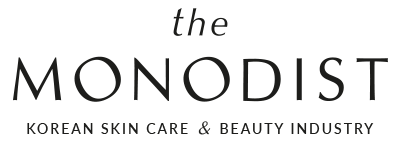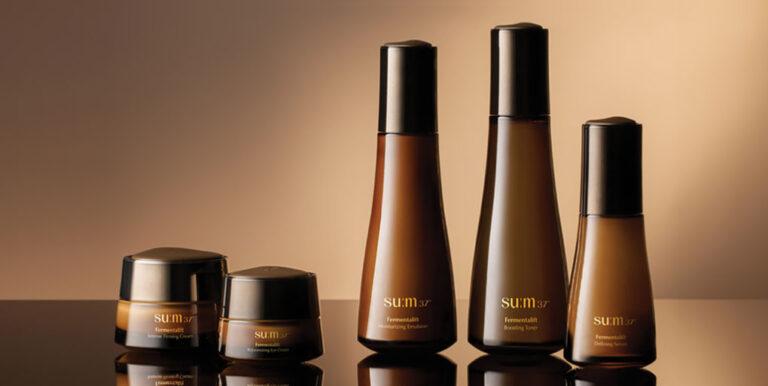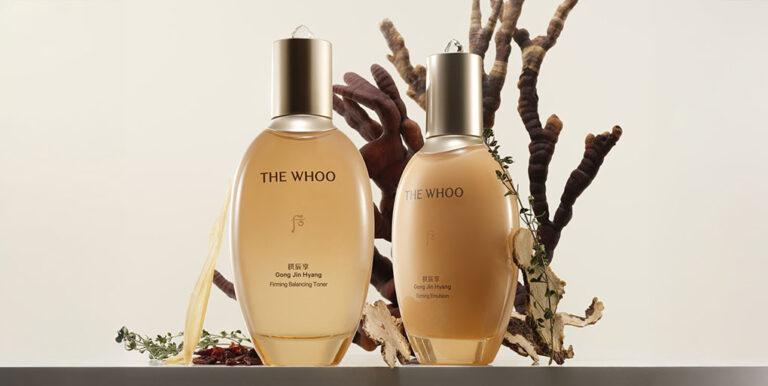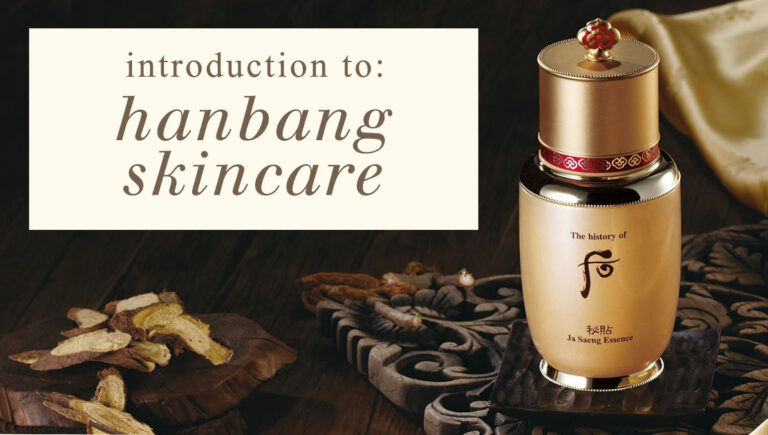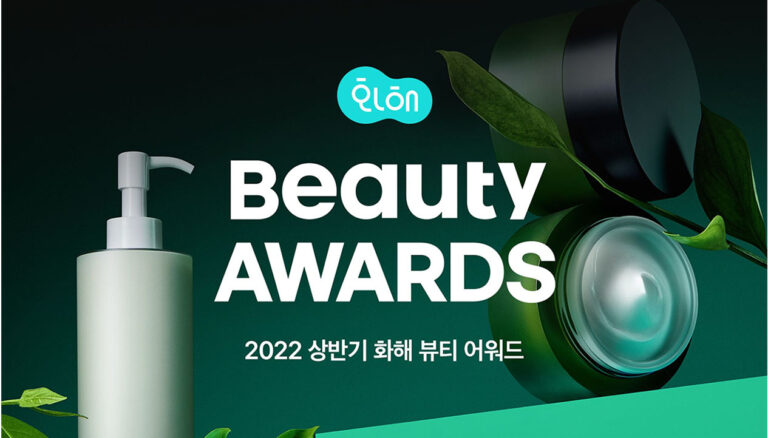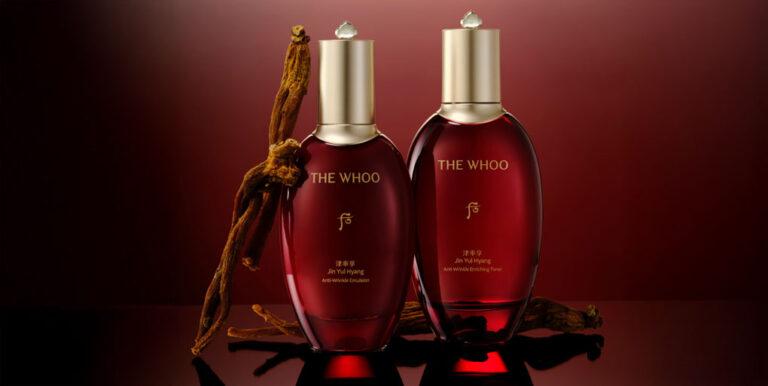korean beauty guides
The Truth About Retinol in Korean Skincare. Myths, History and Top Products
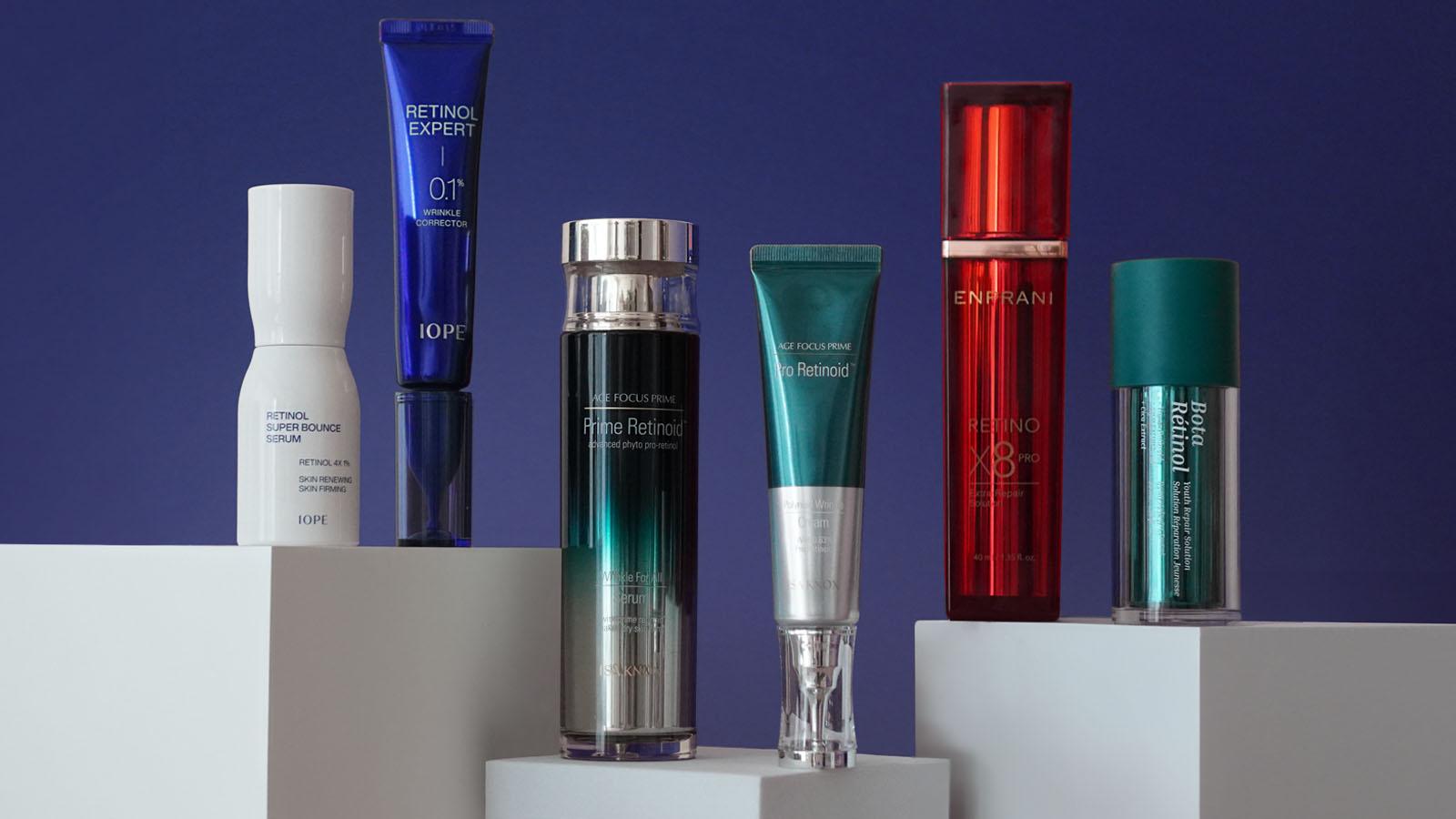
For years there has been a prevailing notion that Retinol is not commonly used in Korean skincare products. But did you know that a cosmetics firm from South Korea was one of the very first beauty companies in the world to stabilise Retinol in 1997? So why are many people under the impression that South Korea is a stranger to the benefits of Retinol?
In this in-depth guide, we will try to understand the reasons behind this myth, examine the history of Retinol research in Korea, and shed light on the companies that pioneered the use of Retinol in Korean skincare.
The article is also available as a video:
Part 1: Retinol in Korean Skincare
For the longest time Western media outlets and self-proclaimed experts have been claiming that Retinol was not commonly used in Korean skincare and only recently became a trend. But did you know that a cosmetics firm from South Korea was one of the very first companies in the world to stabilise Retinol in 1997, at a time where even big foreign conglomerates were struggling to incorporate Retinol in topical skincare treatments?
So why are many people under the impression that South Korea only recently discovered Retinol? Where does this myth originate from? It all comes down to the way Korean Beauty is marketed in the West.
1.1 Age-Based Segmentation in Beauty Marketing
In beauty marketing, we typically classify consumers into three main age groups or market segments: new mums and babies, teens & young adults and older adults.
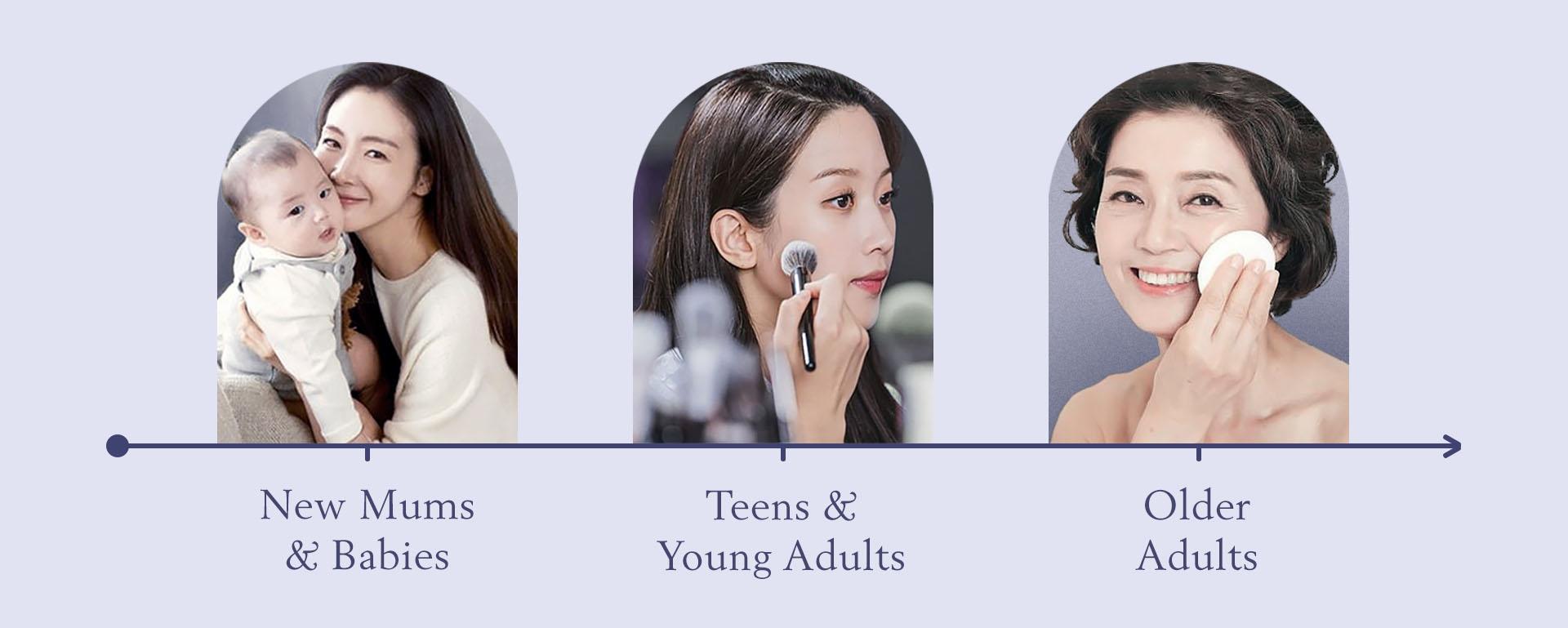
While in some markets, certain brands and products manage to appeal to multiple age groups at the same time, in South Korea there’s frequently a clear division among these marketing segments. Products loved by one group are often unpopular with others and, at times, can even face resistance.
This phenomenon can be observed across all domestic industries. In fact, some of you might be surprised to learn that Samsung smartphones are vastly unpopular among Korean teenagers because they’re strongly associated with an older demographic.
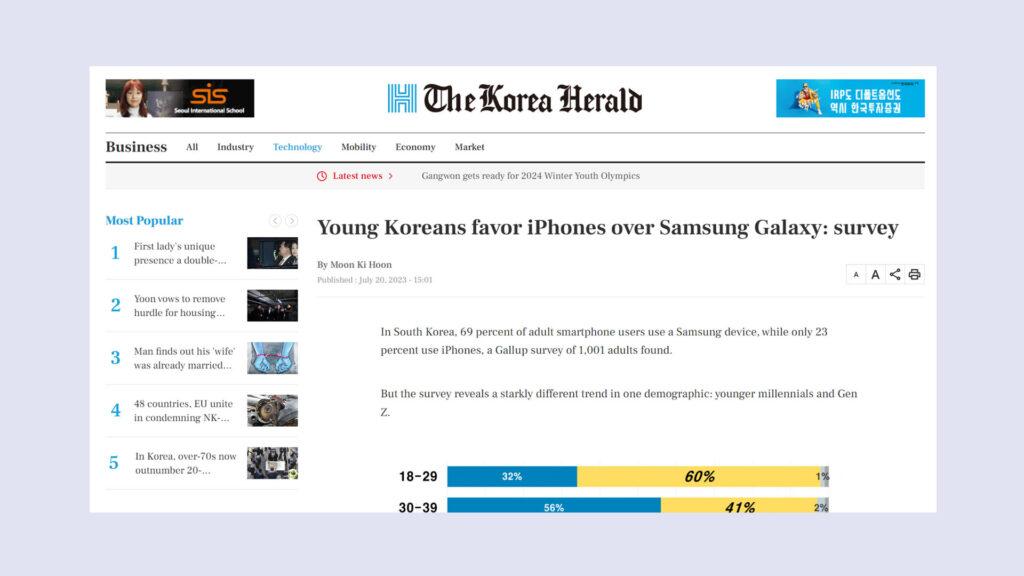
[source: The Korea Herald]
1.2 Korean Beauty Brands For Mature Skin
In Korean beauty, cosmetics targeted towards older adults are commonly referred to as “엄마 화장품” [/om-ma hwa-jang-pum/] in Korean, which translates to “mum’s cosmetics”.
Younger Korean consumers tend to steer clear of these products because they perceive them as “uncool” or connected with an older age group. To give you a better understanding of this concept, I’d like to share with you a clip from a Korean reality show.
In this TV show, a young Vietnamese actress in her 20s is exploring Korea with two Korean pop singers of the same age.
There’s a scene where the three women are getting ready for bed, and during their conversation, the Vietnamese actress reveals that she likes using Sulwhasoo, a Korean beauty brand targeted to older adults. This confession shocks the two Korean women, who quickly point out that Sulwhasoo is typically used by mums, implying that their Vietnamese friend is too young to be using it.
I find that this scene perfectly captures the clear separation among age groups in the Korean beauty industry. Obviously this market segmentation is not exclusive to Korean Beauty. After all, you never see beauty influencers with a predominantly young following such as James Charles recommending products by Olay or Elizabeth Arden to their audience.
The difference is this: if you were raised in a Western country, chances are you’re already familiar with these beauty brands. They were a part of your upbringing. You saw their advertisements in magazines when you were young, perhaps your mother even used some of them. And after the rise of social media, there are still beauty bloggers over 40, albeit not many, who continue to discuss and uphold the legacy of these brands.
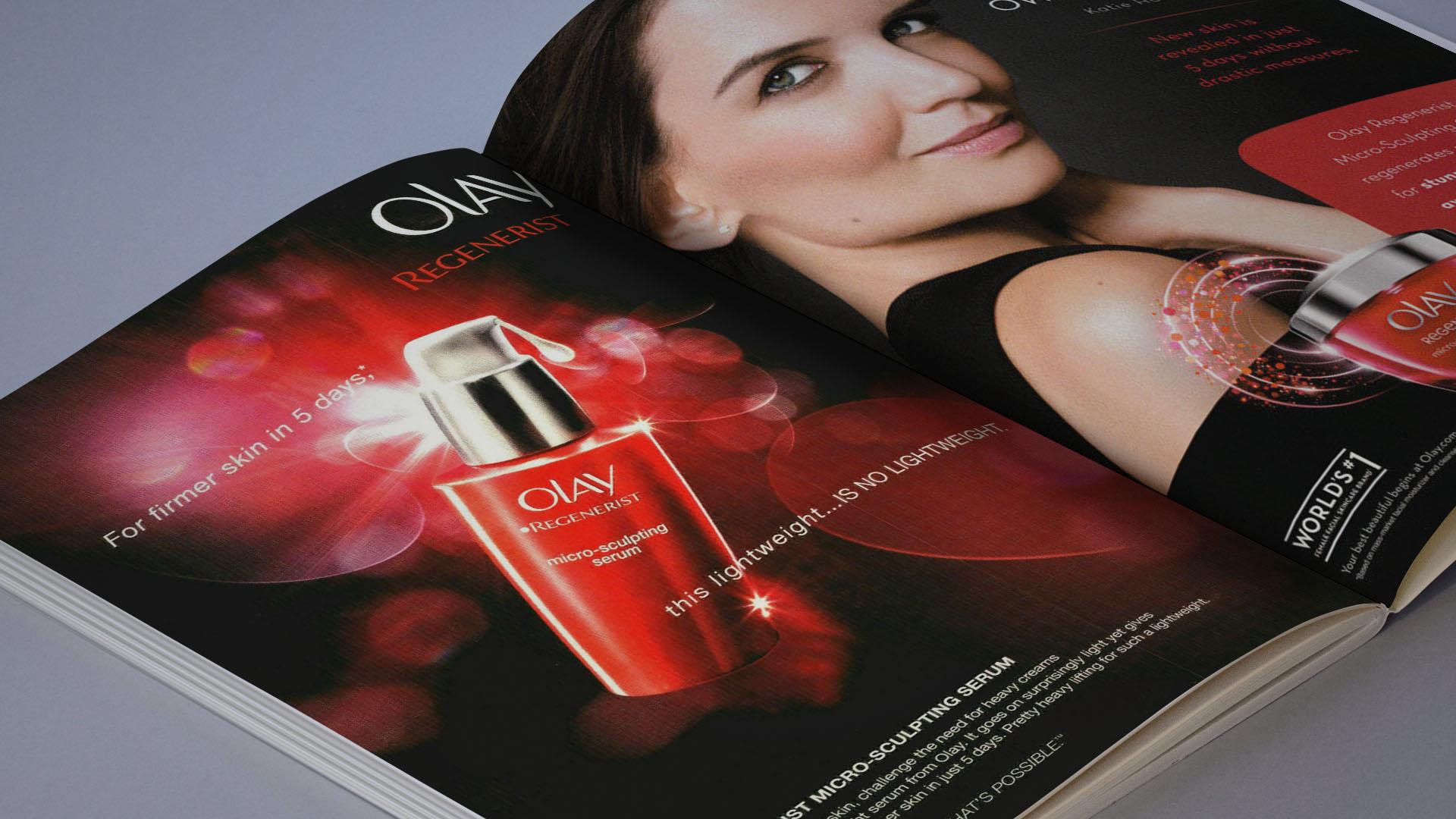
However, when it comes to Korean beauty, the situation is a bit different. Korean Beauty was only introduced in the Western Market 15 years ago and to this day, most people’s only source of information on Korean Beauty is social media.
Problem is: the vast majority of Korean beauty creators active on Youtube, Instagram or Tiktok are young adults in their 20s, occasionally 30s, and the few ones over 40 usually don’t offer English subtitles.
So if those platforms are your only source of information on Korean Beauty, you’ll have a hard time coming across beauty products or brands that are popular among older Korean consumers.
Looking back at the infographic on age-based market segmentation, we can say that for the most part the Western audience is only exposed to the segment of Korean Beauty that refers to teens and young adults. Plus, it’s worth noting there are also beauty brands created specifically for the Western market which are either not available in Korea or are mostly unknown to the general public. Some notable examples are Beauty of Joseon, Purito, and Cos De Baha.
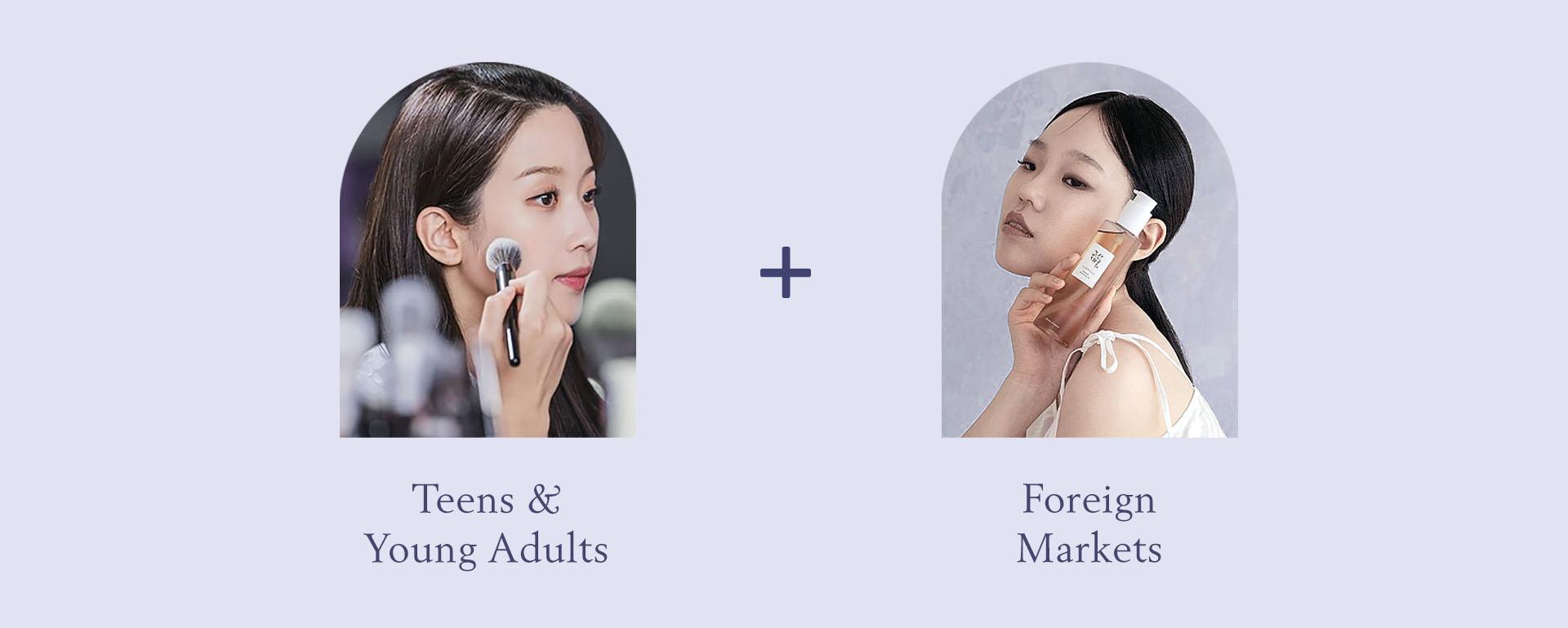
To show you how this age bias limits your perception of Korean Beauty, I’d like to bring up a quick example.
In my guide on The History of Whoo I mentioned the fact that the “Bichup Self-Generating Anti-Aging Concentrate” has been officially recognised as the number 1 best selling anti-aging serum in Korea for the past 12 consecutive years, and yet, how many times have you seen that product mentioned by a Western influencer?
1.3 Understanding Korean Beauty Consumers Over 40
One might wonder: where do older Koreans source their beauty advice, considering they don’t seem to be very active on social media?
Primarily, this demographic relies heavily on word-of-mouth recommendations.
Recent consumer studies show that as Korean consumers grow older, they increasingly turn to friends and acquaintances for advice on cosmetics, with only a small percentage relying on blogs and social media.
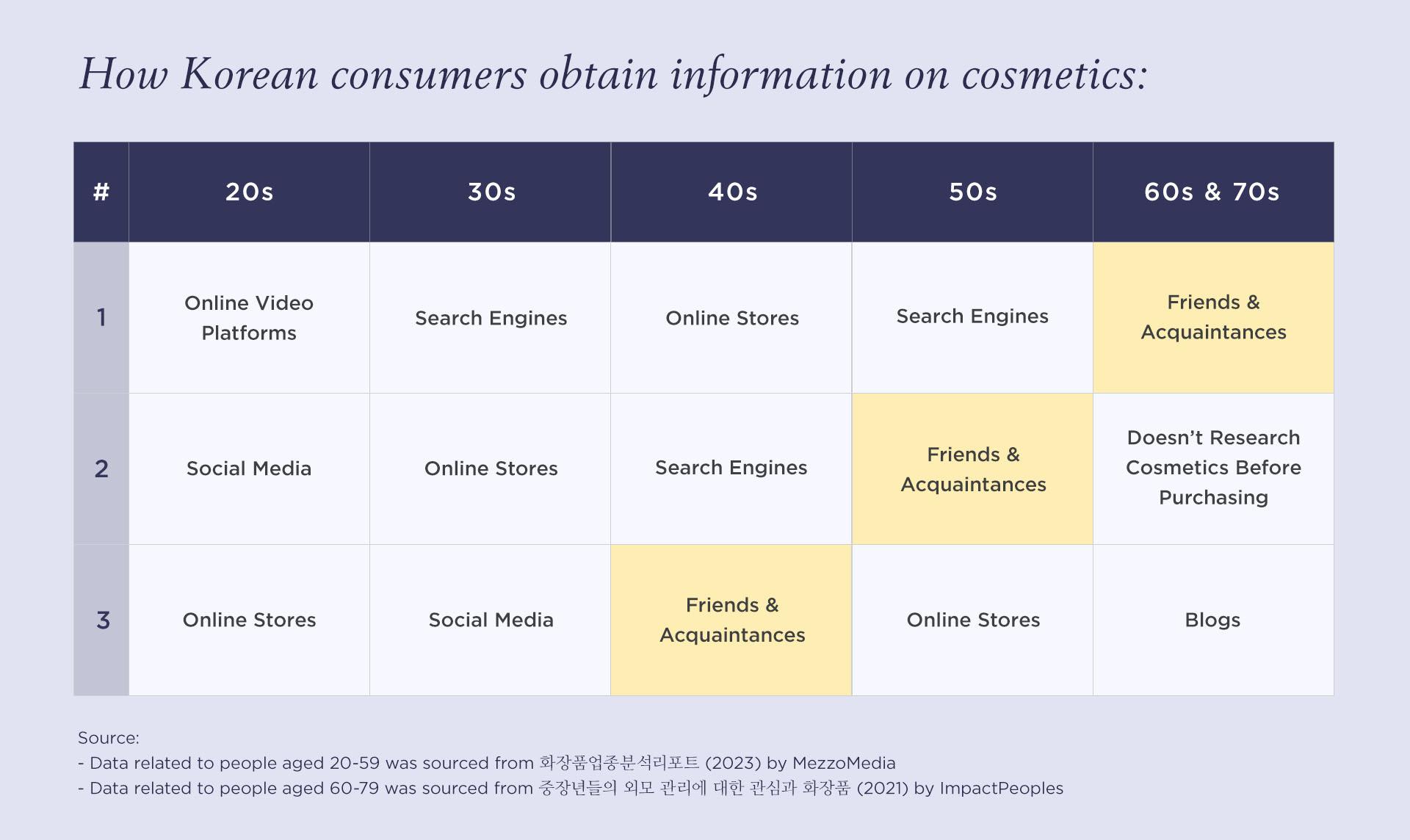
This is also one of the main reasons why beauty brands catering to this demographic often emphasise generous gifts and samples as you may remember from my beauty shopping guide to South Korea. These brands understand the importance of letting customers share these products with friends, knowing they rely on personal networks for advice.
Even when we look at their social media habits, it’s clear that older Korean consumers tend to favour platforms that prioritise opinion exchanges and personal recommendations, such as discussion forums and group chats. Recent statistics on social media usage in South Korea show in fact that Koreans over 40 mainly rely on Naver Band, a Korean group messaging app and Kakao Story, a local social media similar to Facebook.
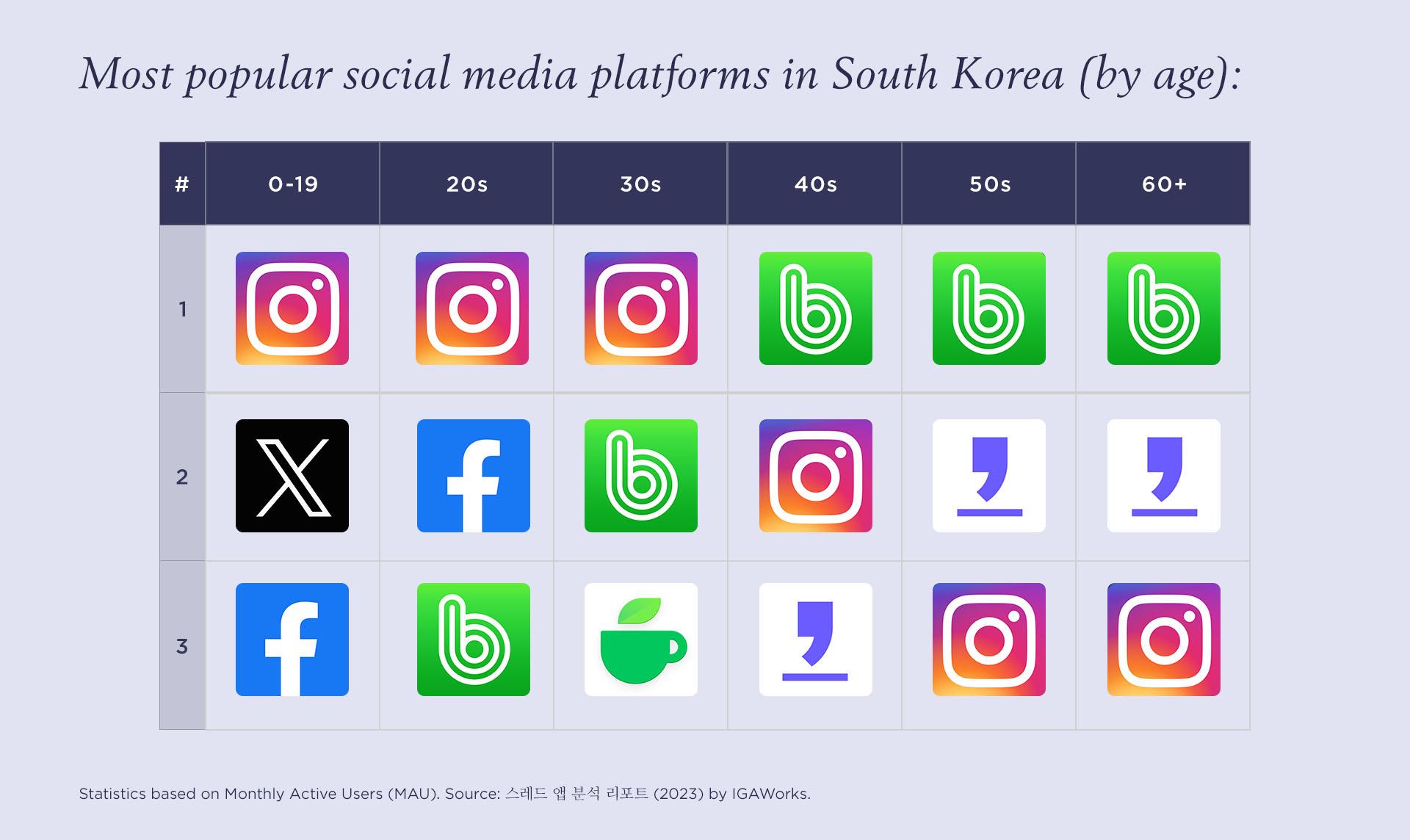
These platforms are vibrant places housing diverse communities. However, when it comes to cosmetics, it’s the women’s communities in particular that play the most important role.
In South Korea there are thriving online communities specifically tailored for mothers and generally women over 35, where they actively engage in discussions about health, fashion, daily life and beauty products. Browsing through these online groups gives you a great idea of the beauty products that are especially popular among older Korean women.
For instance below you can see some pictures shared by the members of a Korean mum community showing their dressing tables. You don’t really see any Etude or Cosrx, do you?
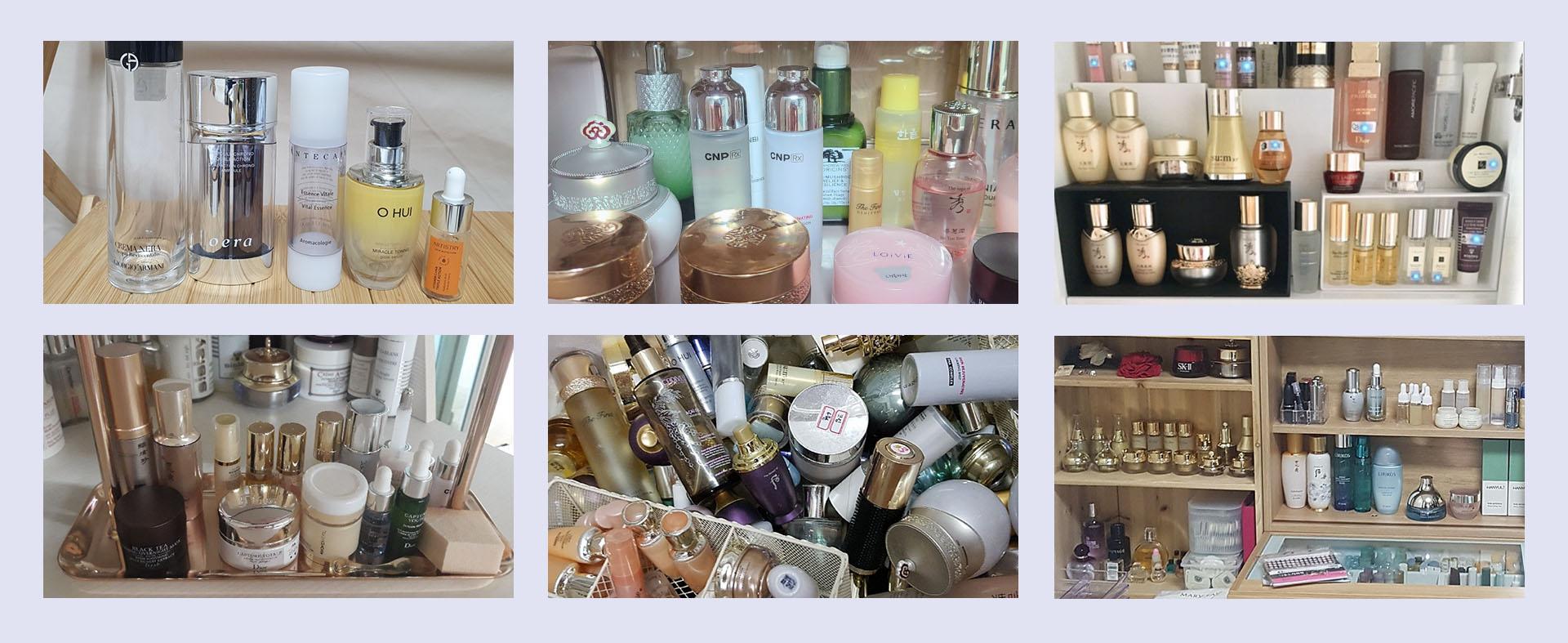
Understanding the habits of older Korean consumers is especially meaningful because until recently, the only Korean beauty brands that used to offer Retinol skincare treatments were brands aimed at an older audience so if one was not familiar with that particular demographic, they could easily get the impression that Retinol was not commonly used in Korean skincare.
To give you a better understanding of this concept, I’d like to take a closer look at the main customer base of the most representative Retinol treatment from Korea.
In recent years many Korean online shops allow users to see demographic information about customers who purchased a particular product, including details such as age group, gender, and skin type. This information can be incredibly helpful when shopping for skincare products because it allows you to see if a product is popular among people of your age group who share similar skin concerns.
Looking at the demographic data related to customers who purchased IOPE’s “Retinol Expert”, which is widely considered to be the most representative Retinol treatment in the history of Korean beauty as we’ll discuss in a minute, we can see that the primary customer base for this product is women over 40.
So despite its reputation in the industry, statistically it’s very unlikely that you’ll see a Korean beauty blogger in their late teens or 20s talking about IOPE’s “Retinol Expert”.
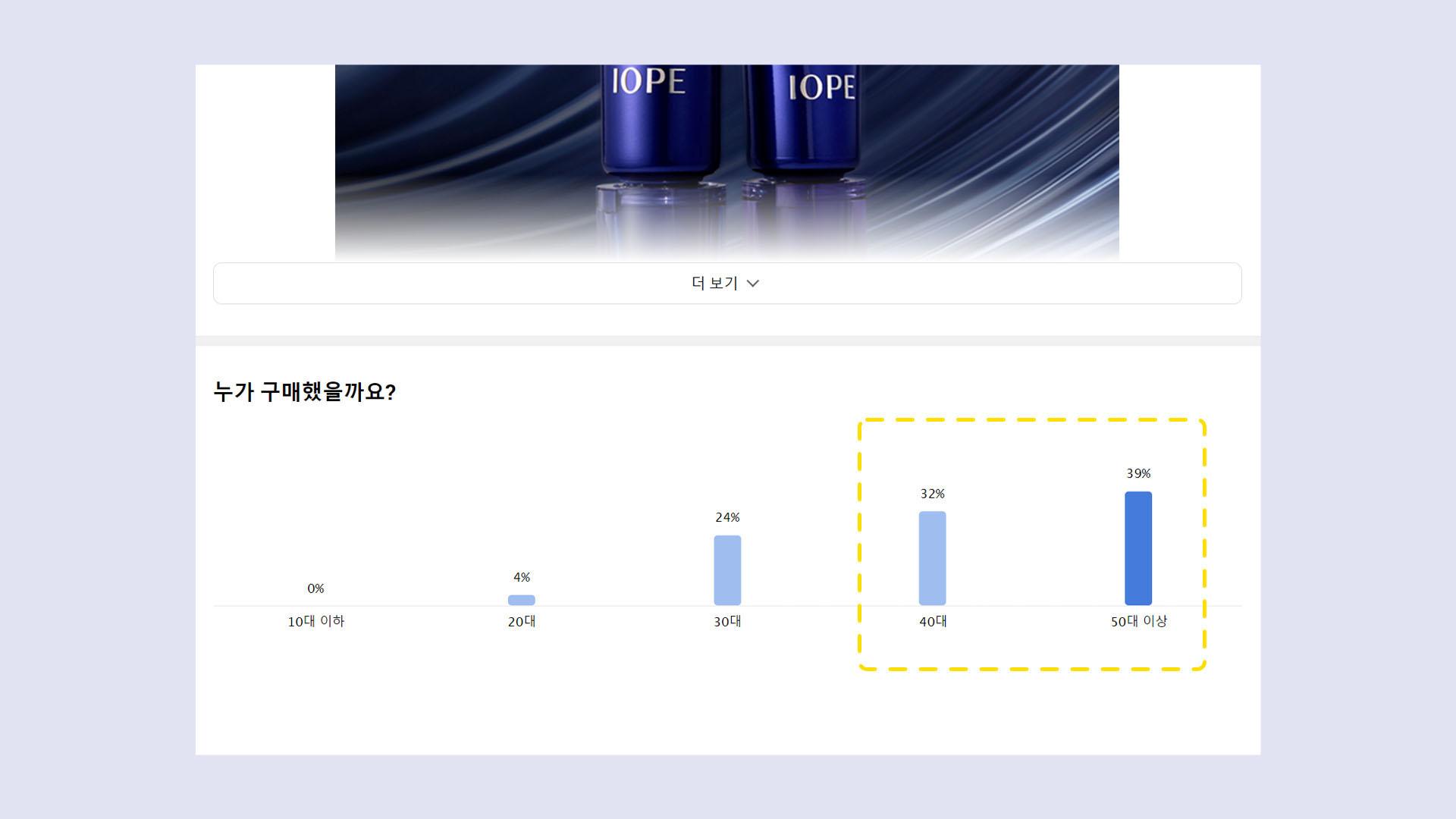
[source: Amoremall]
1.4 The Rise of Anti-Aging Skincare Among Young Korean Consumers
That being said, over the past few years you might have noticed a sudden increase in Korean beauty brands introducing Retinol skincare treatments. This led many people in the West to believe that South Korea only just discovered the benefits of Retinol, when in reality this phenomenon is actually a result of an important shift in the Korean beauty market.
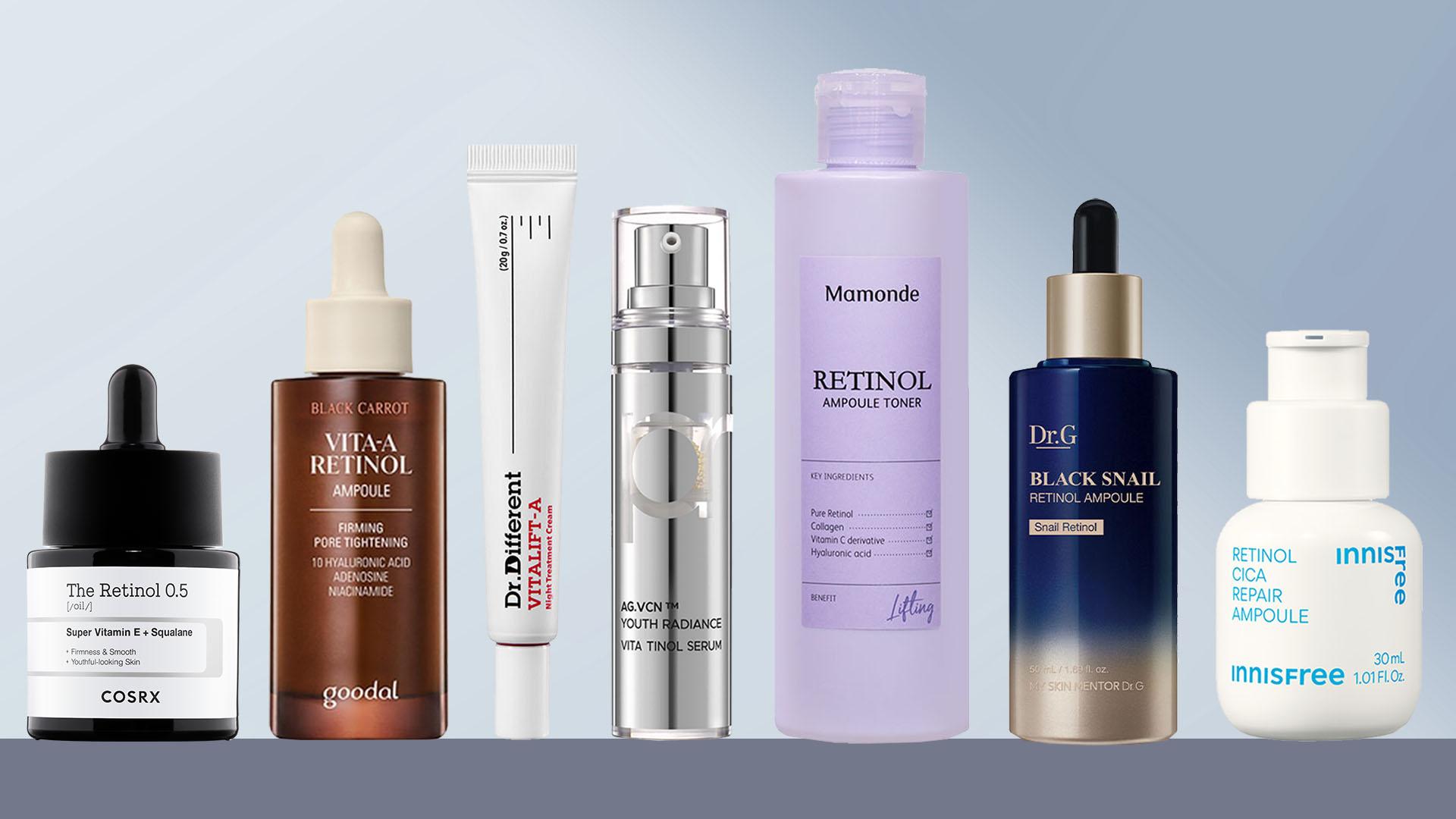
Over the last couple of years, young Korean consumers in their 20s and early 30s have been showing a growing interest in targeted anti-aging and anti hair-loss treatments typically associated with an older demographic.
As you might recall from my video on 2022 Korean Beauty Trends, Korean market analysts dubbed this trend “Gap-less”, to signify the narrowing of the market gap between different age segments.
While it’s still too early to understand the root causes behind this market shift, Korean marketing experts believe it’s mainly a consequence of hectic lifestyles, increased social pressure and poor diets among young adults. In response to this new consumer demand, many Korean beauty brands targeting teenagers and young adults have recently started to introduce anti-aging skincare products, including Retinol-based products.
Since the Western audience is mainly familiar with these particular brands as I previously discussed, one might get the impression that South Korea has only just discovered the benefits of Retinol.
Part 2: Amorepacific
When tracing the history of Retinol research in South Korea, it’s essential to start with Amorepacific, the very first beauty company in Korea to stabilise Retinol in 1997.
Retinol has always been a challenging ingredient to incorporate in cosmetic formulas due to its extreme sensitivity to light, heat and oxygen. Back in the 90s, very few beauty companies in the world possessed the technological expertise required to stabilise Retinol, ROC and Shiseido being the most notable examples. In spite of these challenges, in 1995, the Korean beauty conglomerate Pacific Company, currently known as Amorepacific, recognised the incredible potential of Retinol and decided to secretly embark on extensive research to stabilise the ingredient.

2.1 MDC (“Matrix Double-Capsule”) System Technology
The Pacific Research Institute of Technology worked tirelessly behind closed doors for two years to develop Retinol into a stable cosmetic ingredient and after numerous trials and errors, they came up with a breakthrough idea: encapsulating the molecule using an innovative double encapsulation system called MDC (short for “Matrix Double-Capsule”).
This technology not only preserved the effectiveness of the ingredient by shielding it from oxygen, heat, and light, but also functioned as a sustained-release system, meaning it released the Retinol slowly over time, helping the skin absorb it better while minimising the potential for irritation.
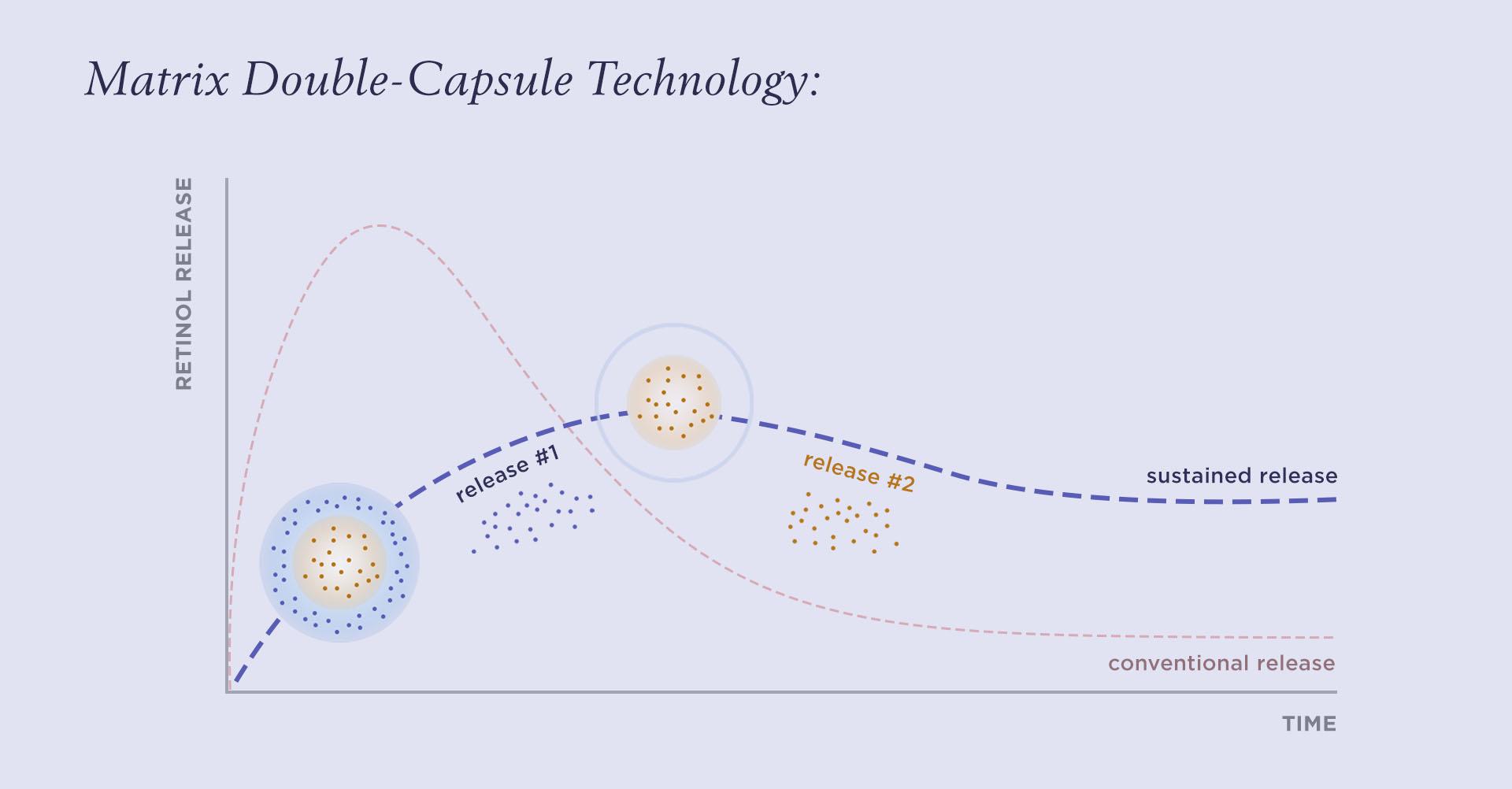
The discovery was so groundbreaking that in 1999 the Korean government recognised Amorepacific’s work on Retinol stabilisation by listing it as one of Korea’s top technological advancements of the 20th century.
2.2 IOPE’s “Retinol 2500”
Amorepacific’s acclaimed Retinol stabilisation technology was originally employed in the formulation of “Retinol 2500”, an iconic Retinol treatment introduced under their brand IOPE in March 1997.
IOPE—short for “Integrated Effect Of Plant Extracts”— is a premium beauty brand launched by the Amorepacific Group in 1996. IOPE has their own dedicated research team within Amorepacific and they’re widely recognised for making high-performance cosmetics that seamlessly fuse cutting-edge technologies with the principles of bioscience.
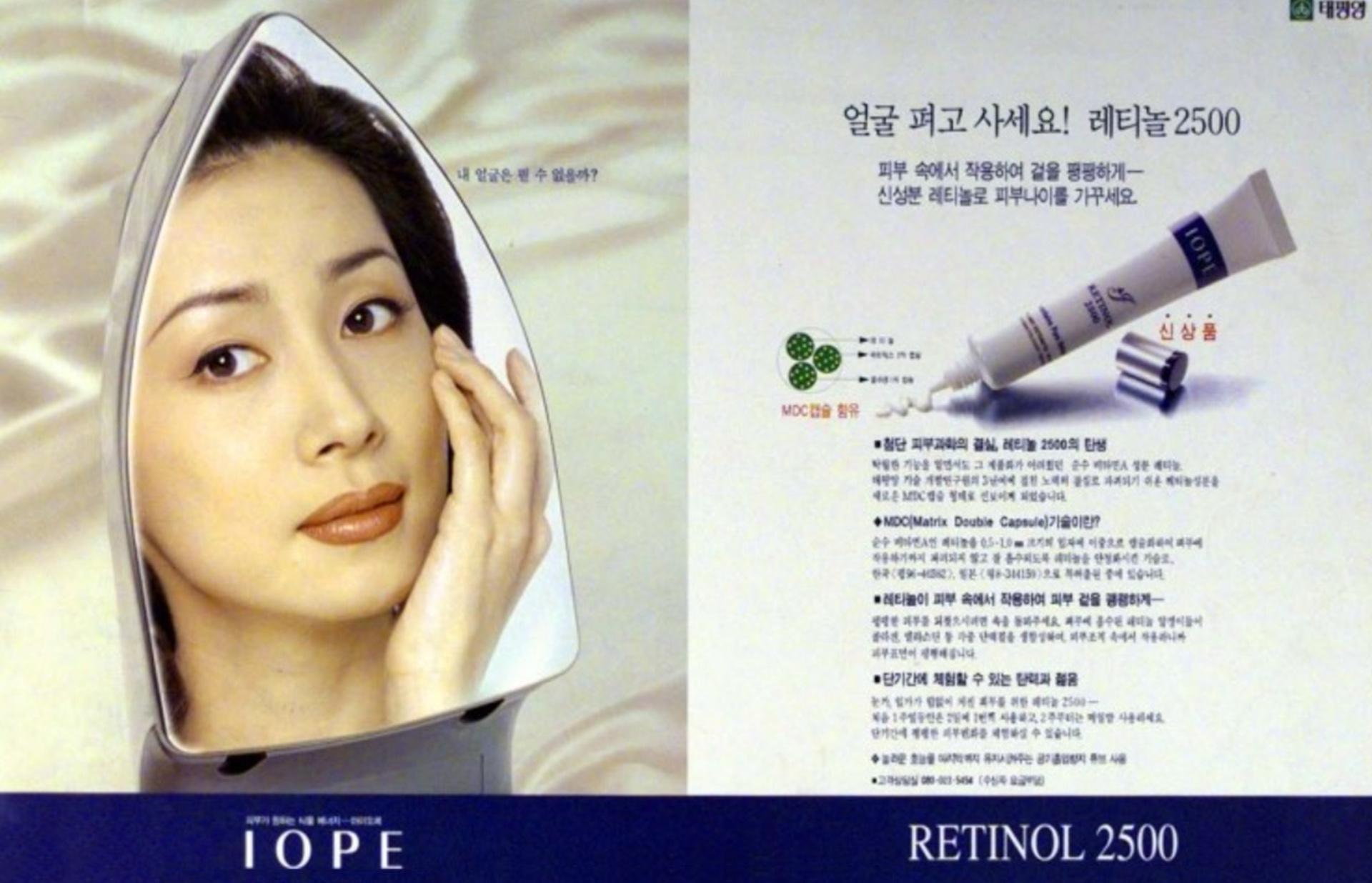
print ad for IOPE’s “Retinol 2500” (1997)
The IOPE team was extremely confident in the quality of their “Retinol 2500” treatment. They secretly chose 1,000 loyal customers over the age of 35 to test the product ahead of its release, anticipating that these women would be so impressed with the results that they would spread the word to their friends and generate buzz before the product launch.
Their strategy paid off and in the first year alone, IOPE’s “Retinol 2500” sold over one million units, making it the number one bestseller for the brand. A title that the product still holds to this day.
After its original launch in 1997, IOPE’s Retinol treatment was reformulated several times. With each reformulation, IOPE tried to find ways to improve the formula and make it more effective. They experimented with various manufacturing methods and molecular structures and tinkered with the materials used in the capsules protecting the retinol. Each reformulation was a step towards making the treatment more potent and stable.
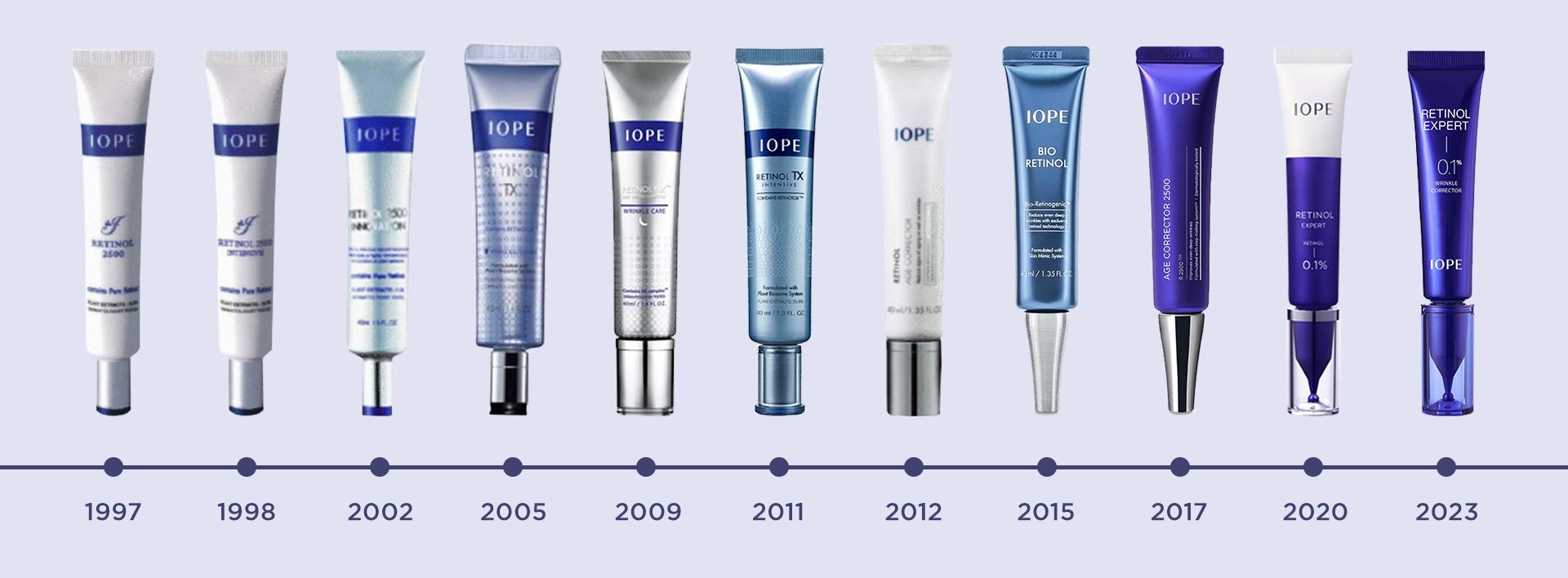
2.3 Breaking Away From Encapsulation
The turning point arrived in 2020, when IOPE proudly announced that they found a way to stabilise Retinol without relying on encapsulation. IOPE’s innovative solution was named “Cube Cell™”.
By combining a multi-phase polymer emulsification technology and a potent antioxidant cocktail, IOPE created a net-like mesh structure that shielded Retinol molecules without relying on conventional encapsulation. This invisible framework acted like protective walls, keeping Retinol molecules separate and stable by preventing chain oxidation reactions.
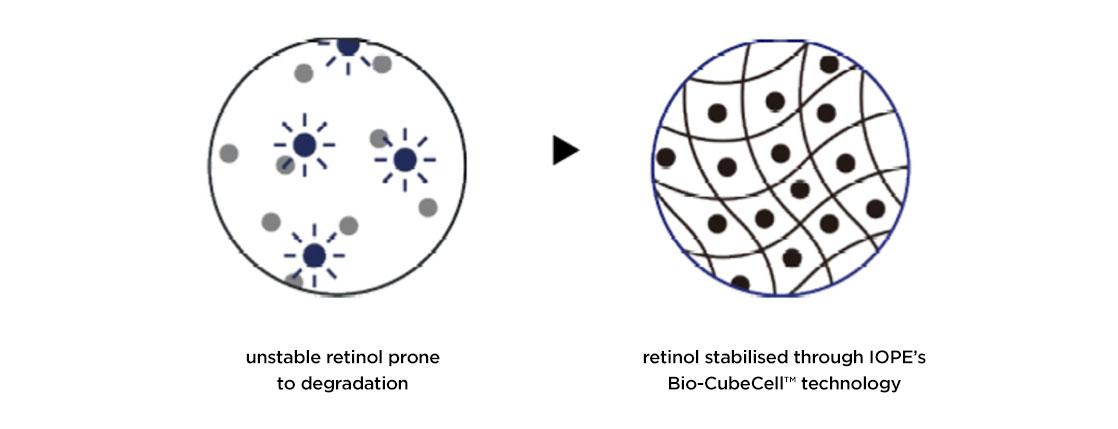
This not only secured the stability of Retinol but also allowed for its rapid absorption upon application. Without the confinement of capsules, pure Retinol could in fact be absorbed quicker by the skin and deliver faster results.
This incredible discovery earned Amorepacific the “Minister of Trade, Industry and Energy Award” at the 2022 Korea Technology Awards, where it was recognised one best Retinol stabilisation technologies in the world.
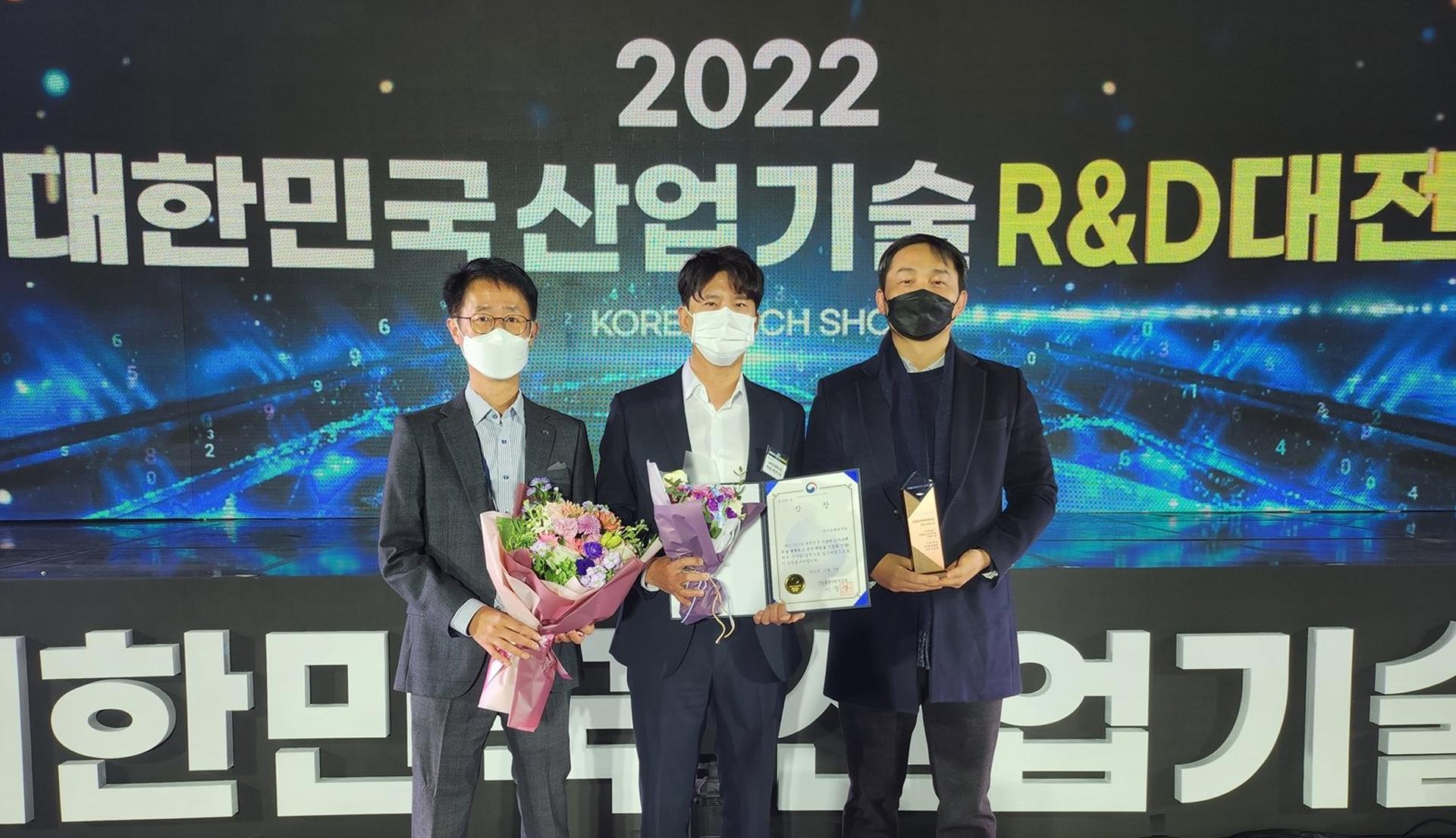
[source: Amorepacific]
2.4 IOPE’s “Retinol Expert”
IOPE’s innovative “Cube Cell™” technology was first commercialised in 2020, when the brand launched “Retinol Expert”, the latest incarnation of their iconic Retinol treatment.
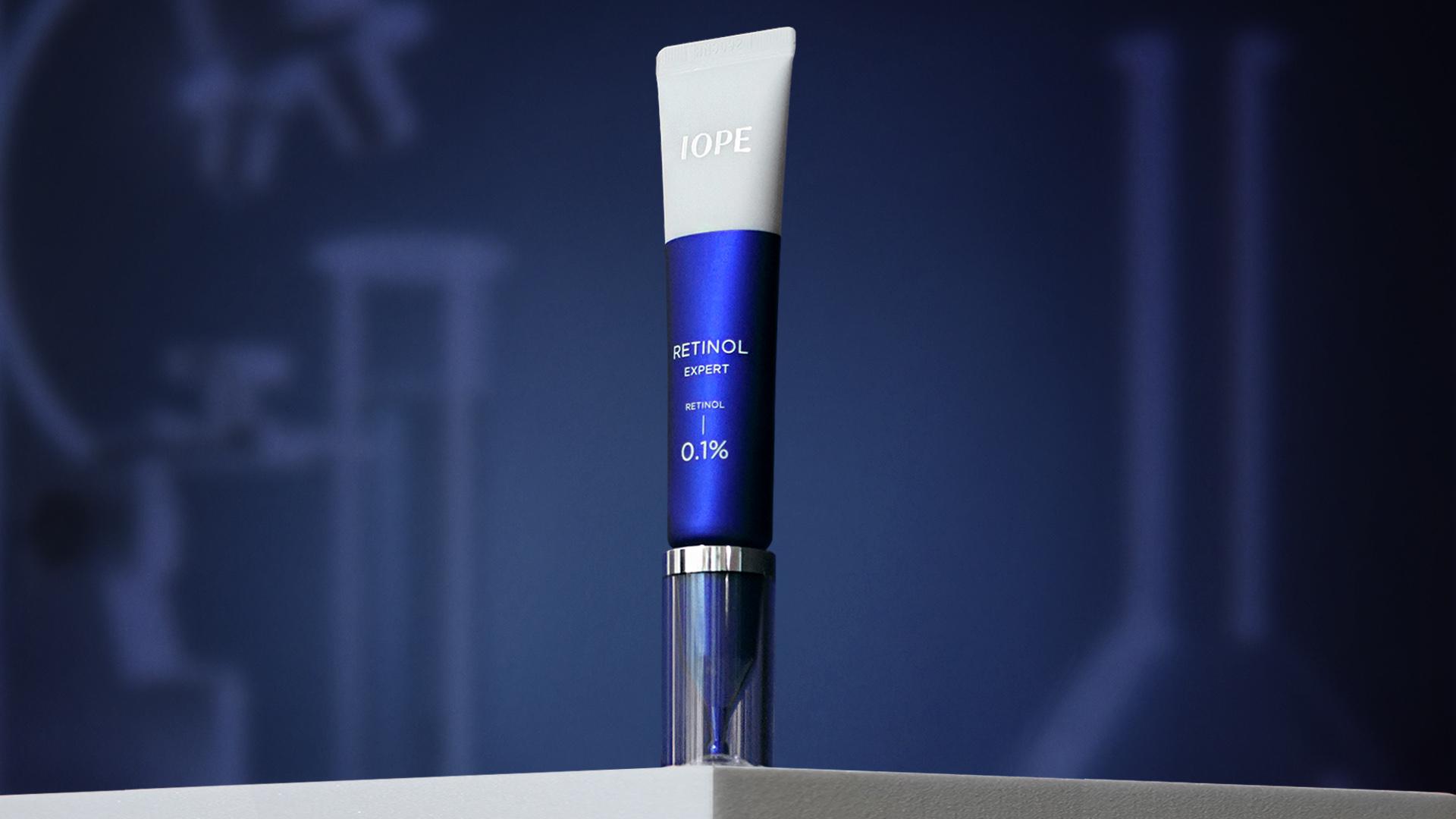
Along with a new stabilisation technology, IOPE’s latest “Retinol Expert” introduced an innovative triple oxygen-blocking container. This peculiar packaging was meticulously designed to minimise the formula’s exposure to light and heat and preserve the treatment’s efficacy from the moment of opening until the very last drop.
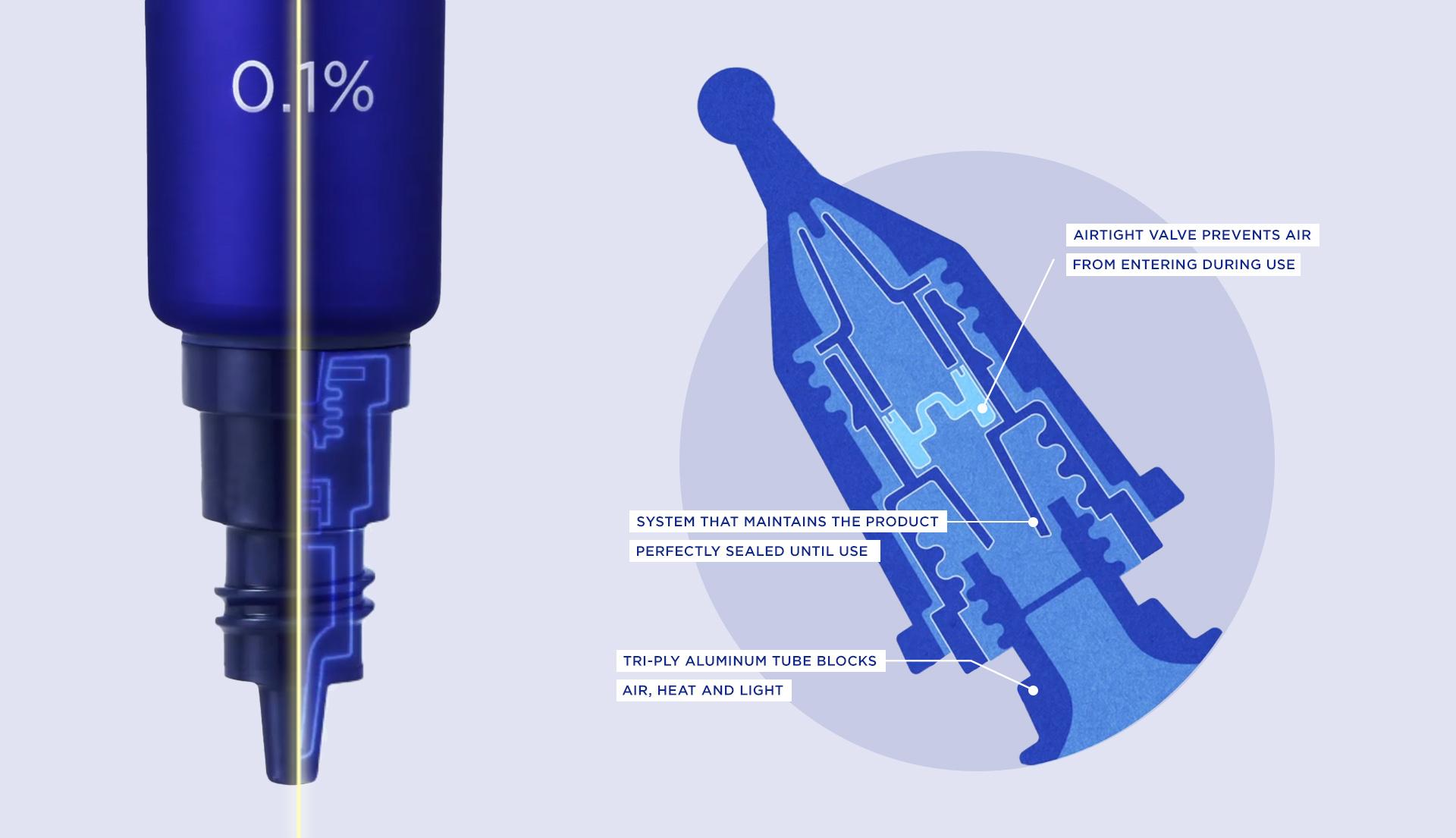
With the launch of the “Retinol Expert” in 2020, IOPE introduced for the first time variants of the product with varying strengths of pure Retinol: 0.1%, 0.2%, and 0.3%, providing users with options to choose the Retinol potency that best suited their individual skin needs and preferences.
2.5 IOPE’s “Retinol Expert Wrinkle Corrector”
Fast forward to 2023, IOPE marked the 27th anniversary since the launch of their iconic Retinol treatment by announcing the release of “Retinol Expert Wrinkle Corrector”, the 11th incarnation of the product.

Unlike the previous version which was available in 3 different strengths, the new “Retinol Expert Wrinkle Corrector” is only available in two strengths: 0.1% pure Retinol and 0.3%.
See also:
- IOPE – Retinol Expert Wrinkle Corrector 0.1% [ingredients and details]
- IOPE – Retinol Expert Wrinkle Corrector 0.3% [ingredients and details]
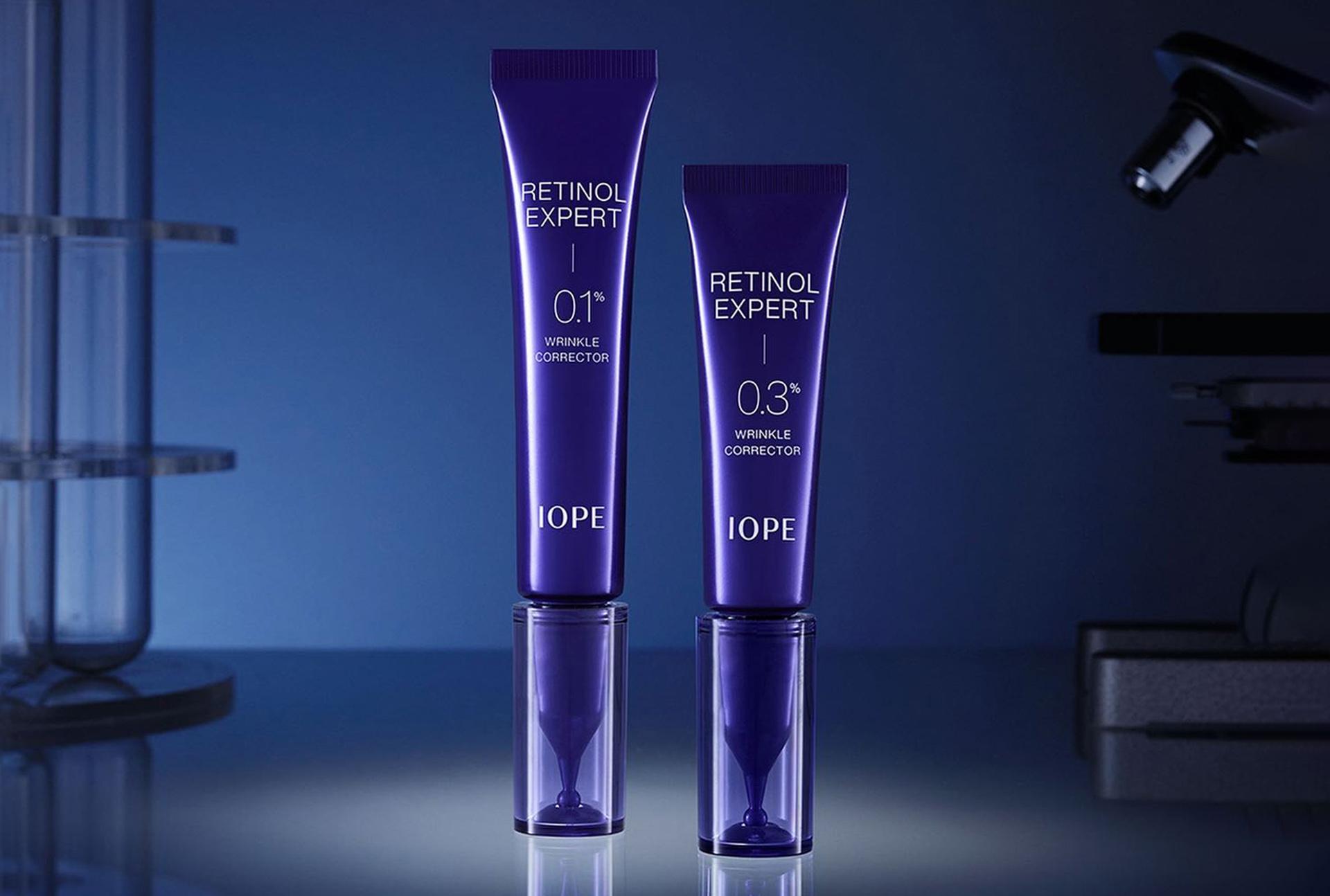
[source: IOPE]
The new “Retinol Expert Wrinkle Corrector” retains the key features of its predecessor, including the same Retinol stabilisation technology and air-tight packaging. In addition, the latest version incorporates several enhancements designed to elevate its performance and effectiveness.
The product boasts a unique blend of pure Retinol alongside encapsulated Retinol. While the pure Retinol delivers immediate benefits, the encapsulated Retinol is wrapped in a protective biocoating that dissolves upon contact with skin enzymes, gradually releasing the Retinol into the skin. This innovative combination not only ensures quick action from the pure Retinol but also provides a sustained and controlled release from the encapsulated form, preventing sudden spikes in Retinoic Acid levels to minimise the potential for irritation.
Furthermore, the new “Retinol Expert Wrinkle Corrector” was also enriched with Granactive Retinoid, a next-generation retinoid derivative that is designed to mimic the effects of Retinoic Acid, but with a lower likelihood of causing irritation. Compared to traditional Retinol, Granactive Retinoid offers similar benefits in reducing fine lines, wrinkles, and uneven skin tone, but it’s been shown to be more stable and less prone to oxidation and degradation and overall, less irritating.
The formula of the new “Retinol Expert Wrinkle Corrector” was also enriched with Bio-Seletinoid™, an internationally-patented ingredient developed by the Amorepacific Group and first commercialised in 2015 after 13 years of research. Bio-Seletinoid™is an innovative anti-aging ingredient crafted through cutting-edge molecular modelling technology. Instead of randomly testing natural extracts to find one that works, Amorepacific decided to create a completely new molecule from scratch that could deliver the desired properties. At its core, Bio-Seletinoid™ is a fusion of two proven skincare components: a segment derived from Retinol, known for its efficacy in reducing wrinkles, and a component from Kojic Acid, an ingredient renowned for its skin brightening properties.
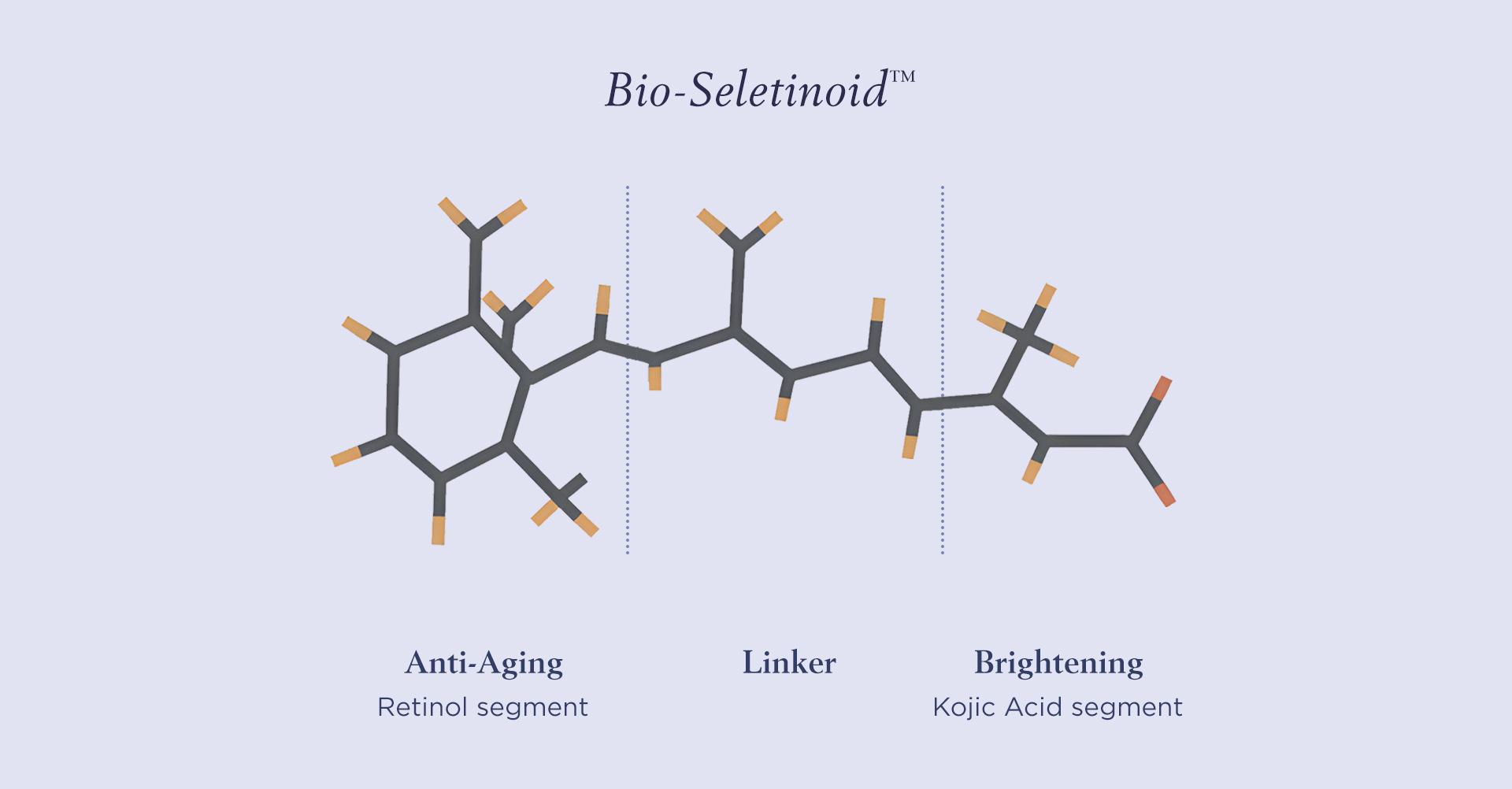
Synthesising these elements into a single molecule that not only retained their individual benefits but also possessed a structure optimised for easy skin penetration was not an easy task and that’s why it took Amorepacific 13 years to perfect Bio-Seletinoid™.
Over the years, the company conducted numerous clinical trials with various synthetic structures until they eventually succeeded in shaping a molecule that penetrates deep into the skin by interlocking with skin receptors, much like a key fitting into a lock.

Bio-Seletinoid™ is an anti-aging superhero that offers a dual-action effect, simultaneously evening out skin tone and enhancing skin elasticity by boosting collagen production. For this reason, the ingredient was recognised by the Korean Ministry of Food & Drug Safety as a dual-functional ingredient.
In South Korea some marketing claims related to skincare like “whitening” or “anti-wrinkle” are strictly regulated by the local authorities.
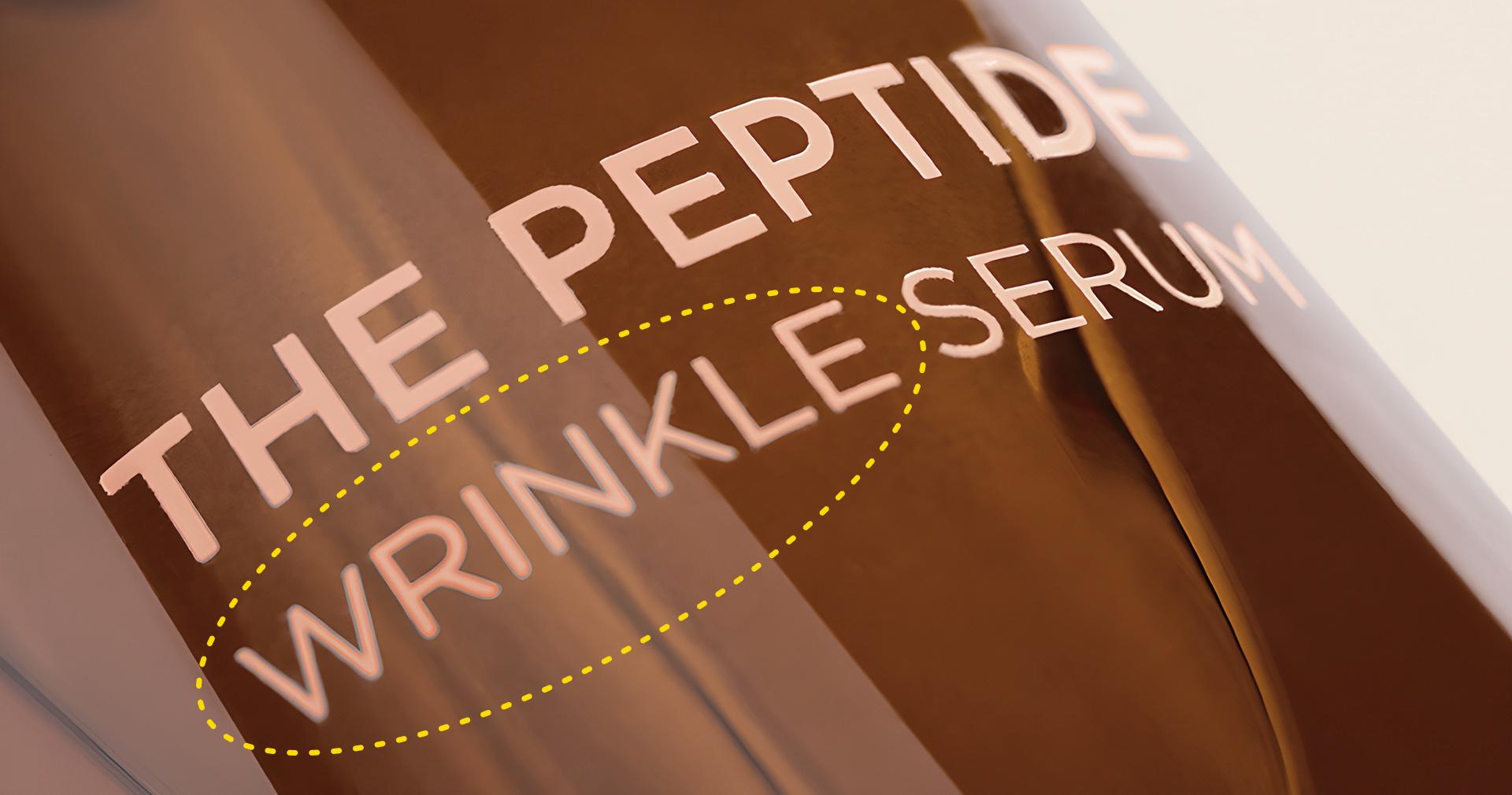
[source: Dermafirm]
Before a company can promote a product using these words, the product has to be registered as a “functional cosmetic”.
In Korea, “Functional Cosmetics” are defined as a category of products with specific functions that help change the condition of skin or hair, as opposed to products that are simply hydrating. In Korean skincare there are only 5 types of functional cosmetics:
- Whitening [meaning “brightening”, NOT skin lightening or bleaching] products
- Wrinkle-improving products
- Rinse-off acne products
- UV-Protecting products
- Skin barrier-restoring products
If a beauty brand wants to claim a product has any of these properties, they must submit to the Korean authorities documentation that shows the safety and clinical effectiveness of the product before they’re allowed to sell it. Plus, the effectiveness should be evaluated by independent testing agencies appointed by the government to avoid any potential bias.
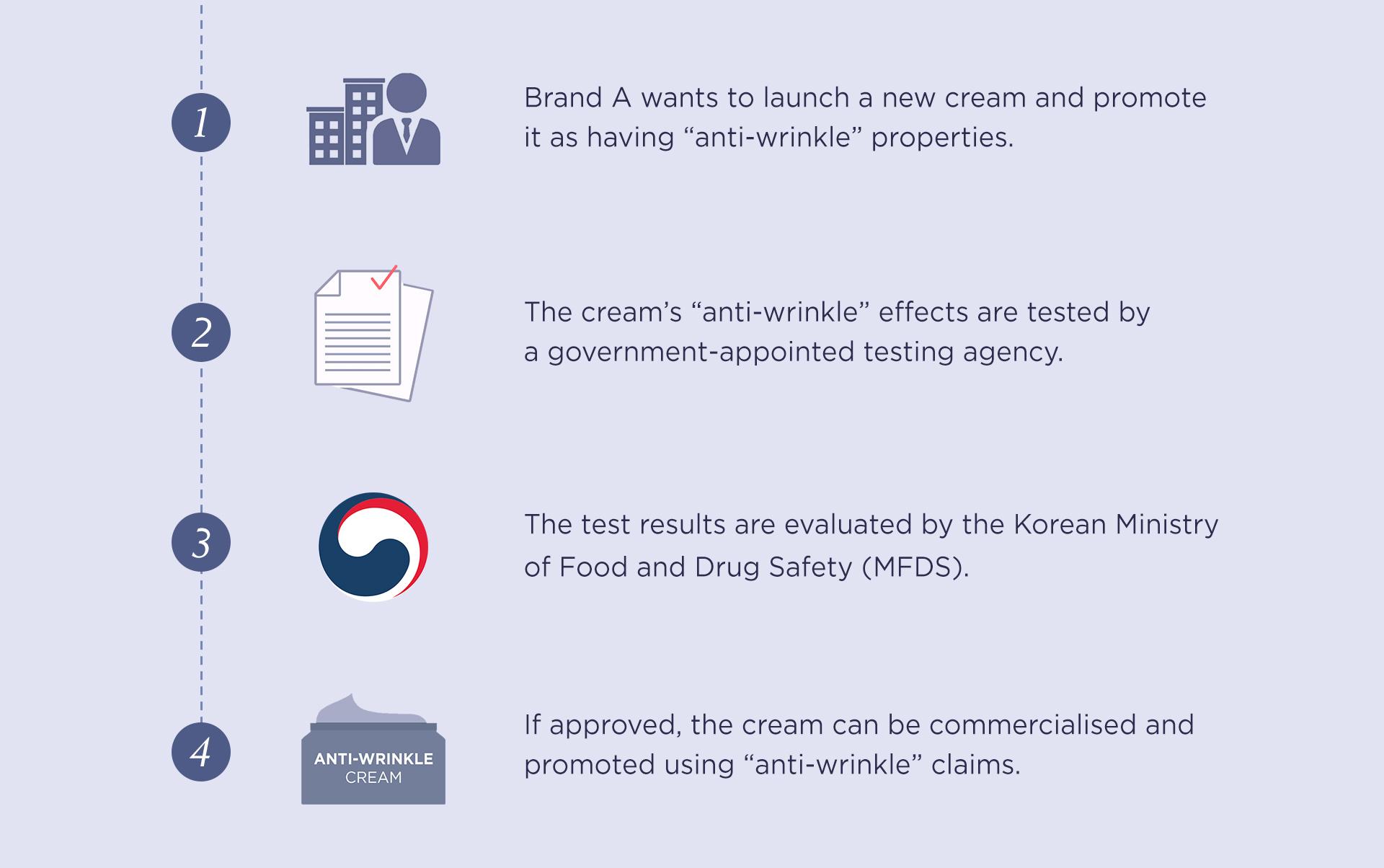
Bio-Seletinoid™ in this case was officially tested and recognised by the Korean Ministry of Food & Drug Safety as a dual-functional ingredient that provides both anti-wrinkle and skin-whitening benefits. The molecule was first introduced as one of the key ingredients of IOPE’s reformulated Super Vital line in 2015 and from 2023 it’s also included in the brand’s iconic Retinol treatment.
Lastly, the new “Retinol Expert Wrinkle Corrector” also contains BX Peptide, which is the name Amorepacific gave to HumaColl21™, an ingredient developed by American biotech company Geltor.
HumaColl21 is defined as a “human-like collagen“. It’s a type of collagen-based peptide developed through biotechnology that is identical to the one naturally produced by the human skin. This means that when it’s applied on the face, the skin is tricked into recognising the collagen as its own and this makes it appear visibly more plump and elastic.
Plus, it was also shown to stimulate production of collagen, elastin and laminin which are the substances mainly responsible for skin’s elasticity. If you’ve been a follower for a while, you’ll probably remember that HumaColl21™ is the signature ingredient of the AHC’s Real Eye Cream for Face franchise.
Amorepacific simply decided to rename the ingredient “BX Peptide” because it’s supposed to produce a botox-like effect.
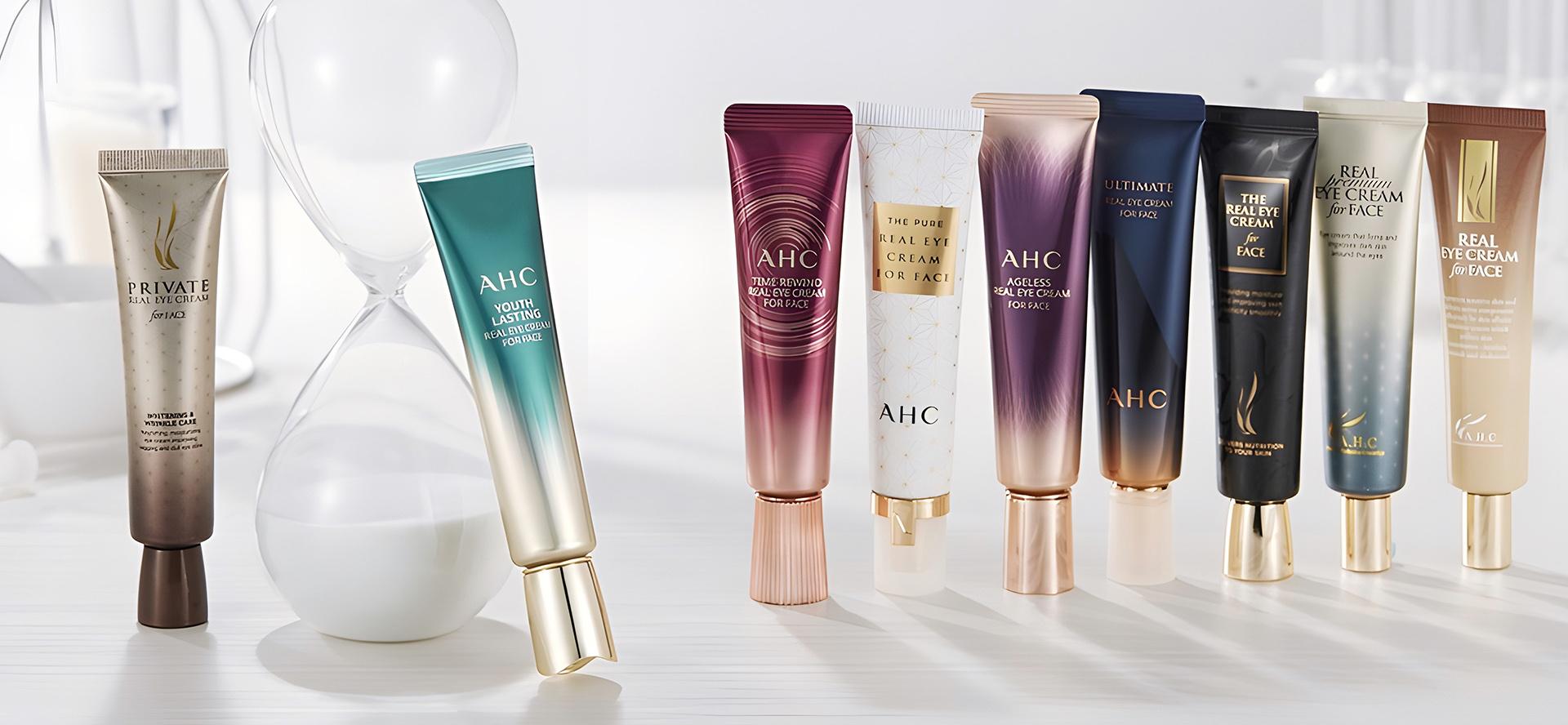
[source: AHC]
In terms of texture, at first I thought the new “Retinol Expert Wrinkle Corrector” was very similar to the previous version, but when I compared them side by side it was easy to see that the latest version was more weightless and absorbed a lot quicker than the previous one.

Overall, I’ve been really impressed by the reformulated ‘Retinol Expert Wrinkle Corrector.’ It’s remarkable how much better it absorbs into the skin compared to its previous version. It also found it delivered quicker, more long-lasting results compared to the old “Retinol Expert”. This reformulation seems to work exceptionally well in improving skin texture, smoothing out wrinkles and fading hyperpigmentation.
2.6 IOPE’s “Super Bounce Retinol Serum”
In 2023 IOPE launched a new Retinol serum called “Retinol Super Bounce Serum”.
See also:
- IOPE – Super Bounce Serum [ingredients and details]
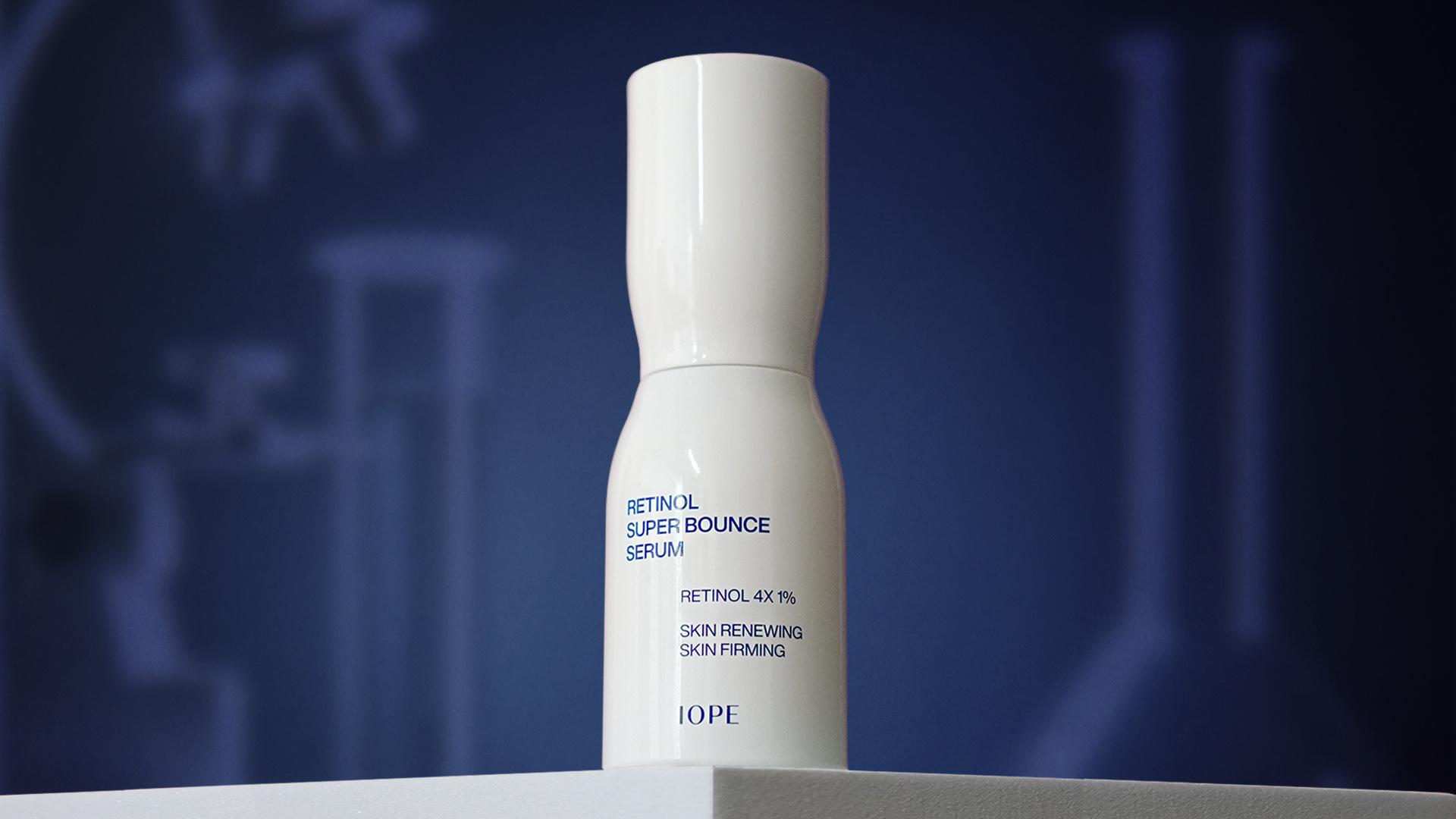
The original packaging of the serum used to read “Retinol 4X 1%”, which may have led some people to believe the serum contained 1% pure Retinol and that it was in fact more concentrated than the “Retinol Expert Wrinkle Corrector”.
In reality, the 1% on the packaging was the sum of all the retinoid ingredients included in the serum. Like the “Retinol Expert Wrinkle Corrector”, the “Retinol Super Bounce Serum” contains 4 types of retinoids, that’s why it says “Retinol 4X” on the packaging, and they are: pure Retinol, encapsulated Retinol, Bioseletinoid™ and Granactive Retinoid.
However, in terms of pure Retinol content,the serum contains only a small amount of Retinol compared to the “Retinol Expert Wrinkle Corrector” line.
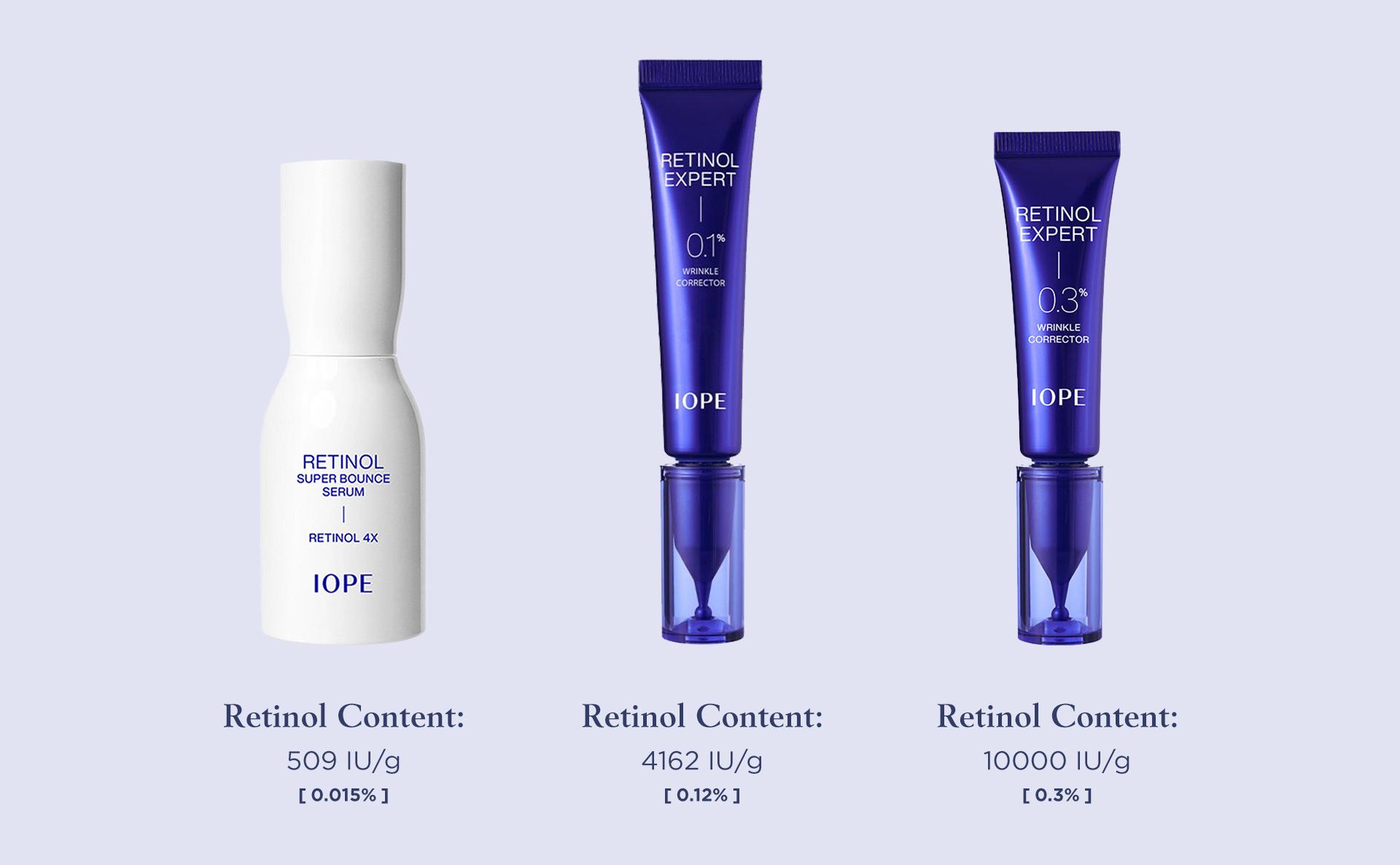
Meaning the “Retinol Super Bounce Serum” is way more mild than the “Retinol Expert Wrinkle Corrector” even in its low strength variant and for this reason, on their Korean website IOPE recommends the serum as a beginner Retinol treatment that can also be used during the day.
A few months ago, IOPE changed the packaging of the serum to remove all mentions of the 1%, so they must have realised they made a misleading marketing claim, but I still wanted to mention this fact in case you came across some old marketing materials for this serum.
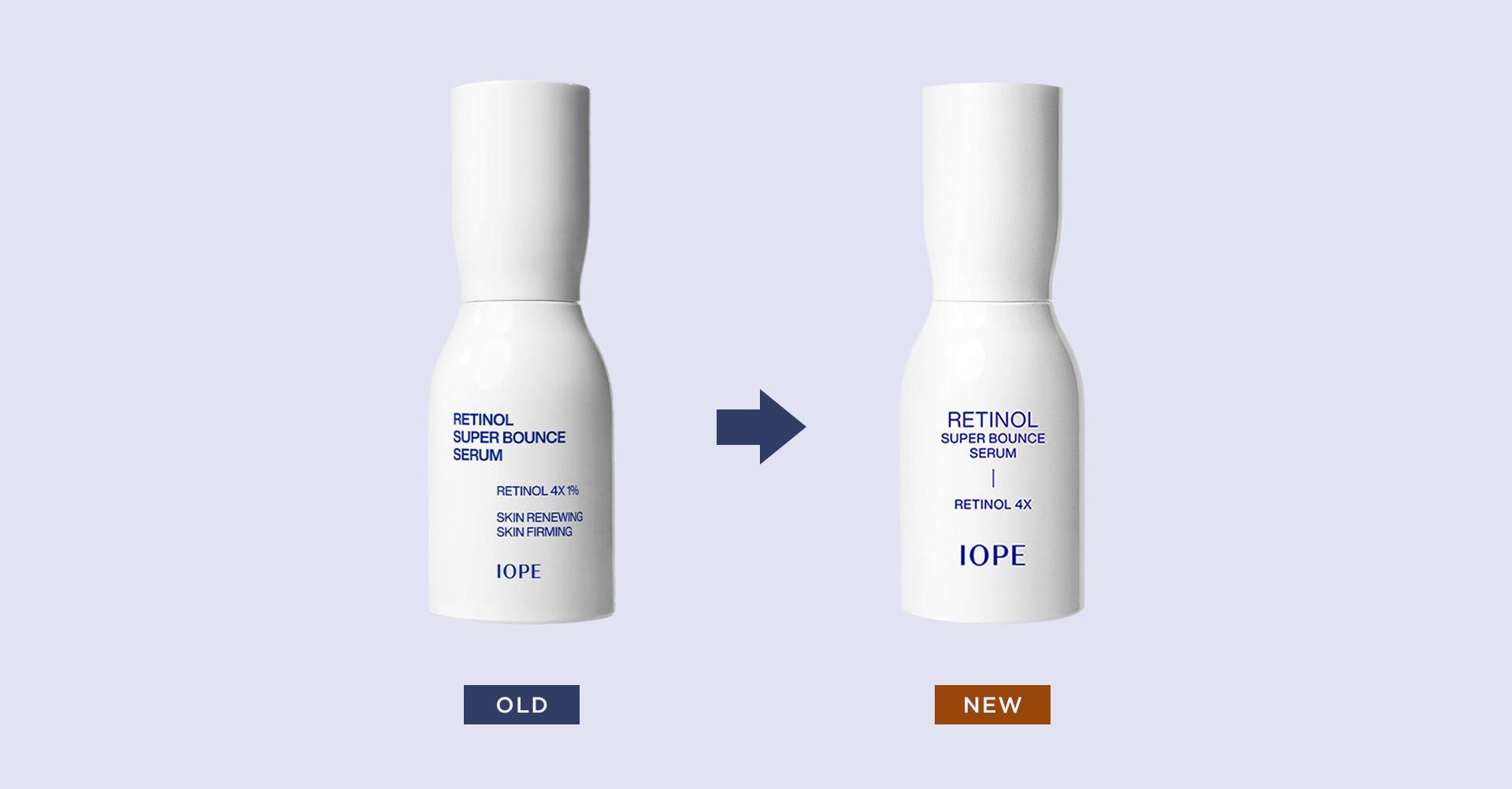
In terms of performance, this serum is indeed a beginner-friendly mild Retinol treatment, so if you’re already used to the potency of the “Retinol Expert” treatment, like I am, you might not experience the same dramatic results. For advanced users, IOPE recommends to use the “Retinol Super Bounce Serum” in combination with the “Retinol Expert Wrinkle Corrector” for quicker results, but personally I didn’t find the serum made a big difference in my case.
It’s also worth noting that while the “Retinol Expert Wrinkle Corrector” contains fragrance, even though it’s very weak, the “Retinol Super Bounce Serum” doesn’t contain fragrance or essential oils and it’s more suitable for highly-sensitive skin.
Part 3: LG Household & Health Care
In addition to Amorepacific, the LG Group is one of the top Korean beauty companies renowned for its extensive research on retinoids.
While the Amorepacific Group has historically focused on researching effective methods to stabilise Retinol in cosmetic formulas, LG has dedicated their efforts to overcoming the drawbacks associated with retinoids, including irritation, instability, and poor absorption.
In recent years in particular, they have been delving into genomics to investigate the impact of genetics on Retinol-induced skin irritation. For instance, two years ago they published a study, in which they used DNA profiling to identify 10 specific genes associated with Retinol-induced skin irritation.
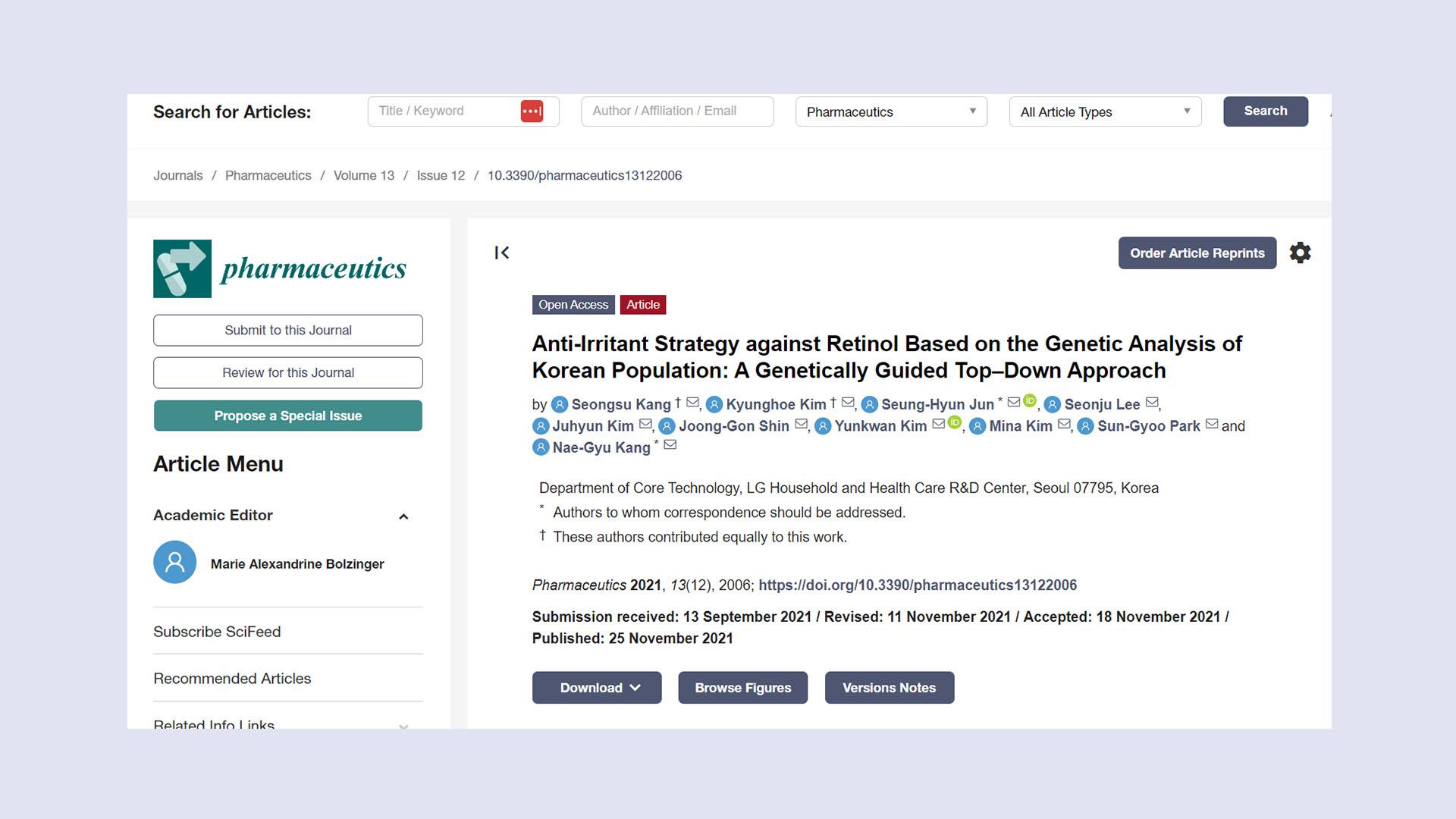
[source: Pharmaceutics]
Building on this research, LG is currently focused on creating cosmetic products that can suppress the activity of these genes and provide anti-aging benefits without causing any irritation.
But LG’s venture into retinoid research began in the late 1990s.
3.1 The Development of Medimin A
As previously discussed, incorporating Retinol into cosmetic formulas has always been a challenge. This ingredient is highly sensitive to light, heat, and oxygen, which makes it difficult to work with.
Faced with these challenges, LG said: instead of trying to perfect what is known to be an inherently unstable ingredient, why not create a completely new retinoid molecule through bio-design that didn’t have all these drawbacks? This new molecule would provide equivalent, if not superior, benefits to Retinol but with reduced instability and irritation.
In the 90s there had already been attempts to develop more stable retinoid derivatives like Retinoic Acid esters and amides. While these new derivatives were less irritating, studies revealed that they had limited ability to penetrate the skin and were generally less effective.
LG’s goal, on the other hand, was to develop a new retinoid molecule that would offer improved stability, reduced irritation, but high effectiveness.
LG’s breakthrough arrived in 1999 with Medimin A (Polyethoxylated Retinamide) —a novel retinoid ingredient engineered to overcome the traditional limitations of Retinol.
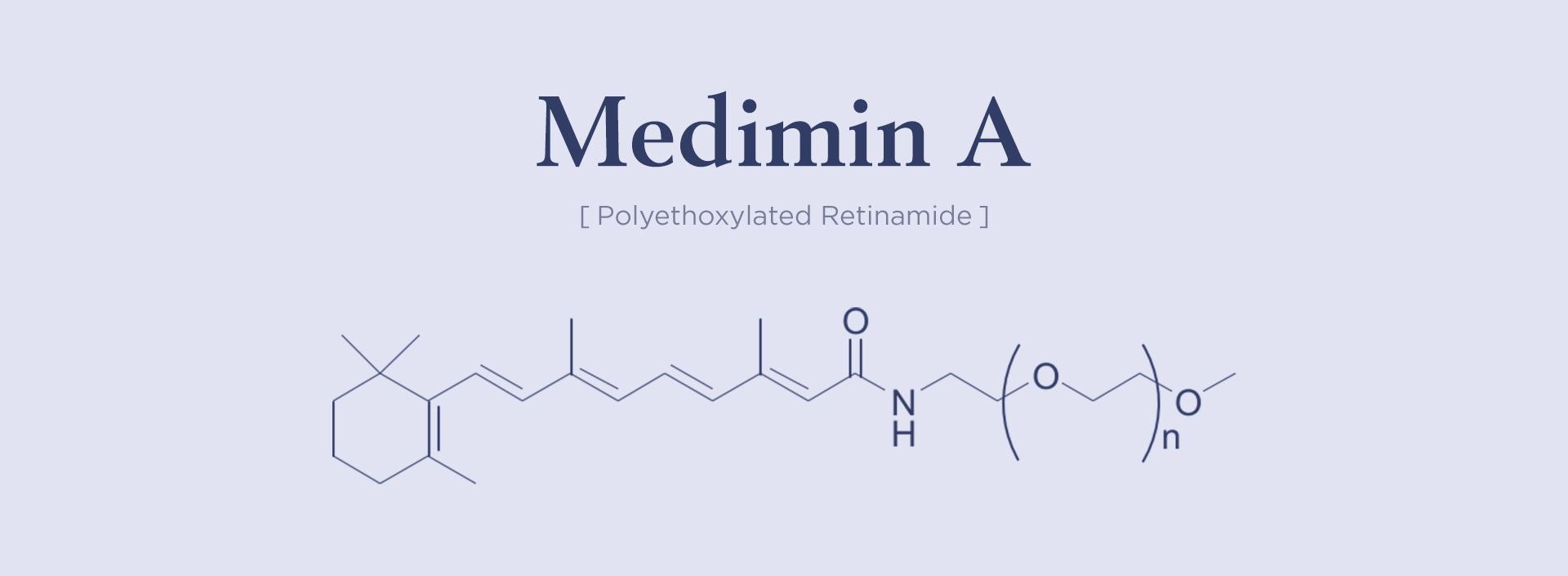
Medimin A, is the result of a 3 year joint research conducted by the LG Cosmetic Research Institute and the Biotechnology Research Institute of LG Life Science.
In the West, LG is best known for its household appliances and electronic products. However, LG is actually a massive holding group with separate divisions operating under its umbrella. Apart from their Electronics division, which most people are familiar with, they have divisions dedicated to cosmetics, chemicals, electronic displays, and more. Each division functions as a distinct legal entity within the LG group. LG Life Science in this case, is part of the Chemical division of the LG Group and focuses on developing and manufacturing pharmaceuticals and biotechnology products.
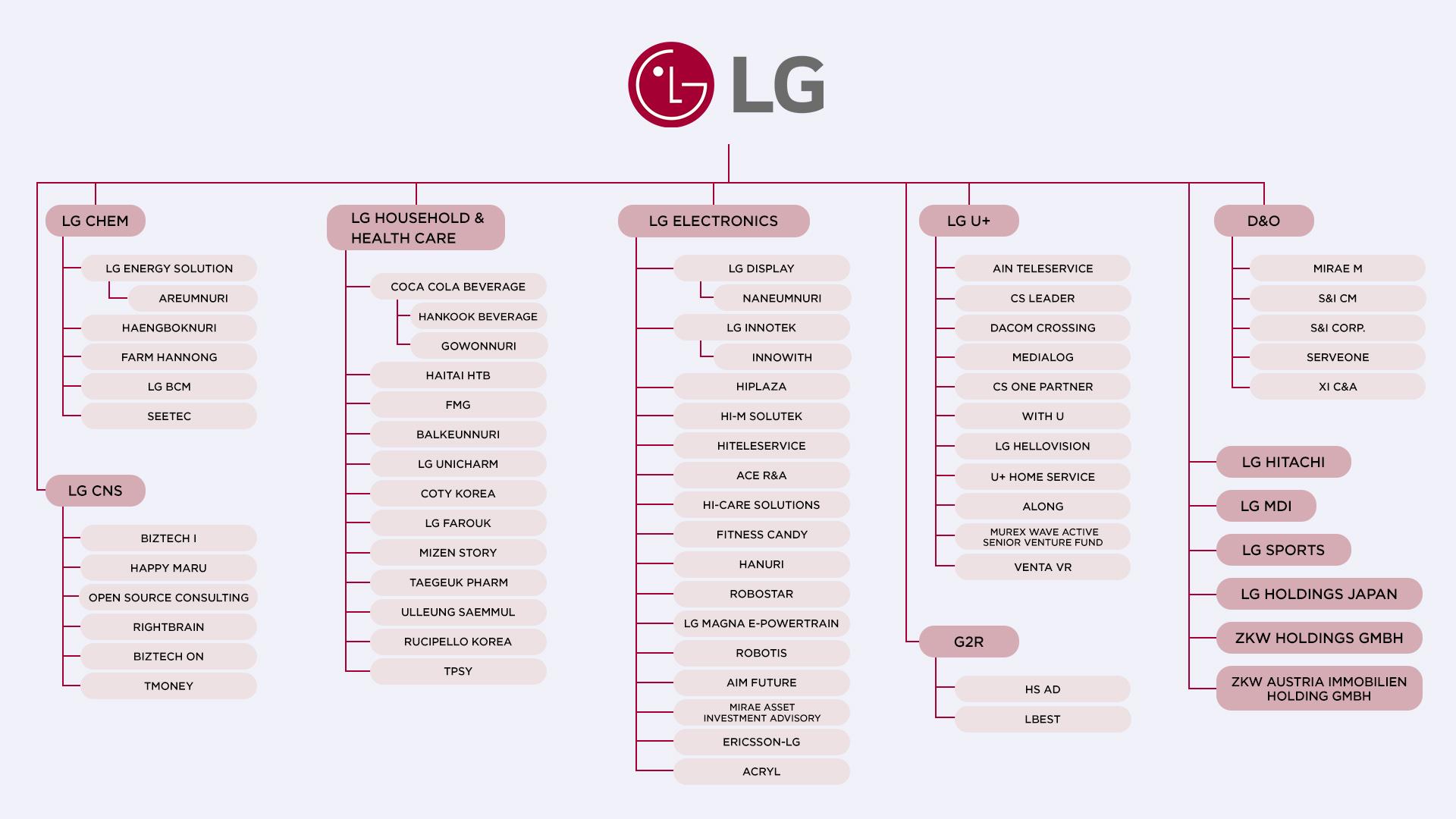
[source: LG Group. Translation & Visuals: Odile Monod]
While studying the properties of Polyethylene Glycol (also known as PEG), the LG Life Science research team made some interesting discoveries.
First of all they noticed that molecules derived from PEG exhibited excellent surface activation properties, essentially priming the skin to interact more effectively with other substances. Secondly, it was observed that these derivatives enhanced skin absorption due to their water-friendly nature. Similar to how a wet sponge absorbs more liquid, these derivatives boosted the skin’s ability to absorb substances. Lastly, Polyethylene Glycol derivatives were found to dissolve easily in water. This meant that even though they were part of a product applied to the skin, they could be flushed out of the body without causing any irritation.
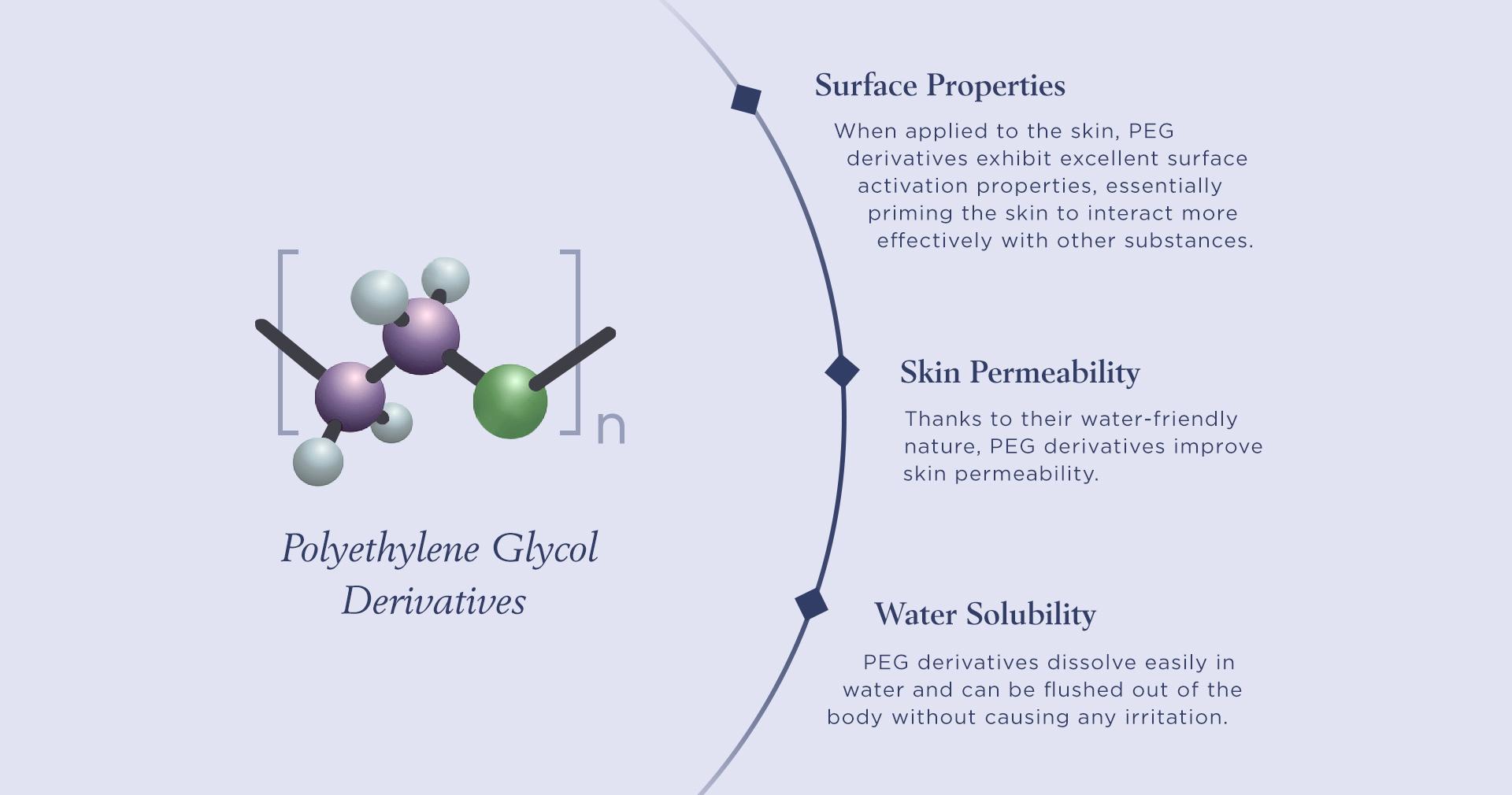
Building on these observations, the LG researchers had an intuition: combining Polyethylene Glycol with Retinoic Acid to create Medimin A, a new retinoid ingredient that was more stable than Retinol, less irritating, but effective at the same time.
Not only that, but it was also the first retinoid molecule entirely developed and manufactured in Korea, marking a significant milestone for the domestic beauty industry, which previously depended on imported retinoid ingredients.
To create a stable retinoid molecule, they used an amide condensation process. In this chemical process, two molecules join together to form a new compound by creating a strong and highly-stable connection called an amide bond. This newly formed bond works a little bit like superglue to enhance the stability of the original ingredients, in this case for instance it makes the Retinoic Acid within Medimin A more stable, allowing it to preserve its effectiveness without the need for ingredient encapsulation.
This enhanced stability also made Medimin A more photostable, making it more convenient to use during the day compared to traditional Retinol.
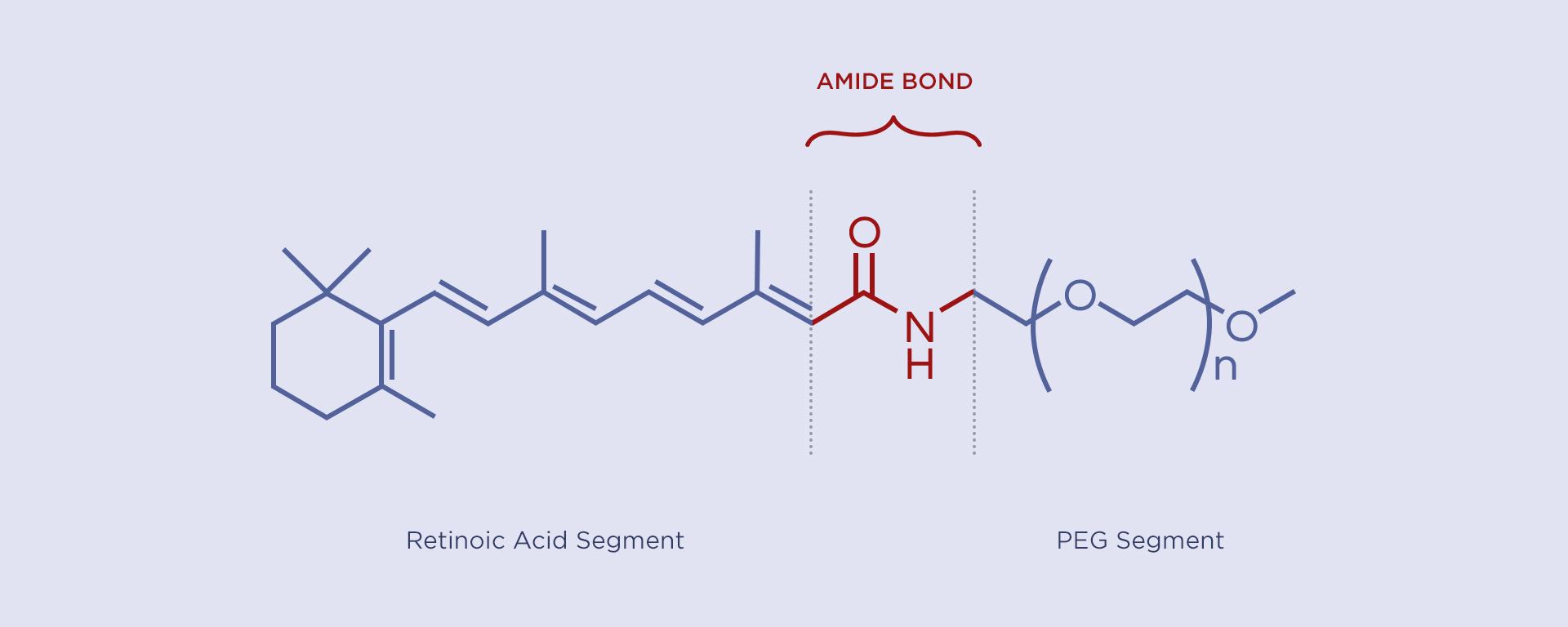
In addition, LG’s research team made great efforts to minimise the typical irritation usually associated with retinoids. They came up with a particular delivery system for Medimin A that combined an amino acid liquid crystal gel system and an S/W (Silicone in Water) emulsion.
The liquid crystal gel system created a stable and protective environment that effectively held the Medimin A within its structure and made it more bioavailable through the use of amino acids, facilitating absorption. On the other hand, the silicone-in-water emulsion provided an additional layer of protection for the Medimin A molecule and helped ensure a controlled release of the ingredient.
This mechanism allowed for a controlled and gradual delivery of the ingredient to the skin, preventing sudden spikes in Retinoic Acid levels and reducing the risk of irritation.
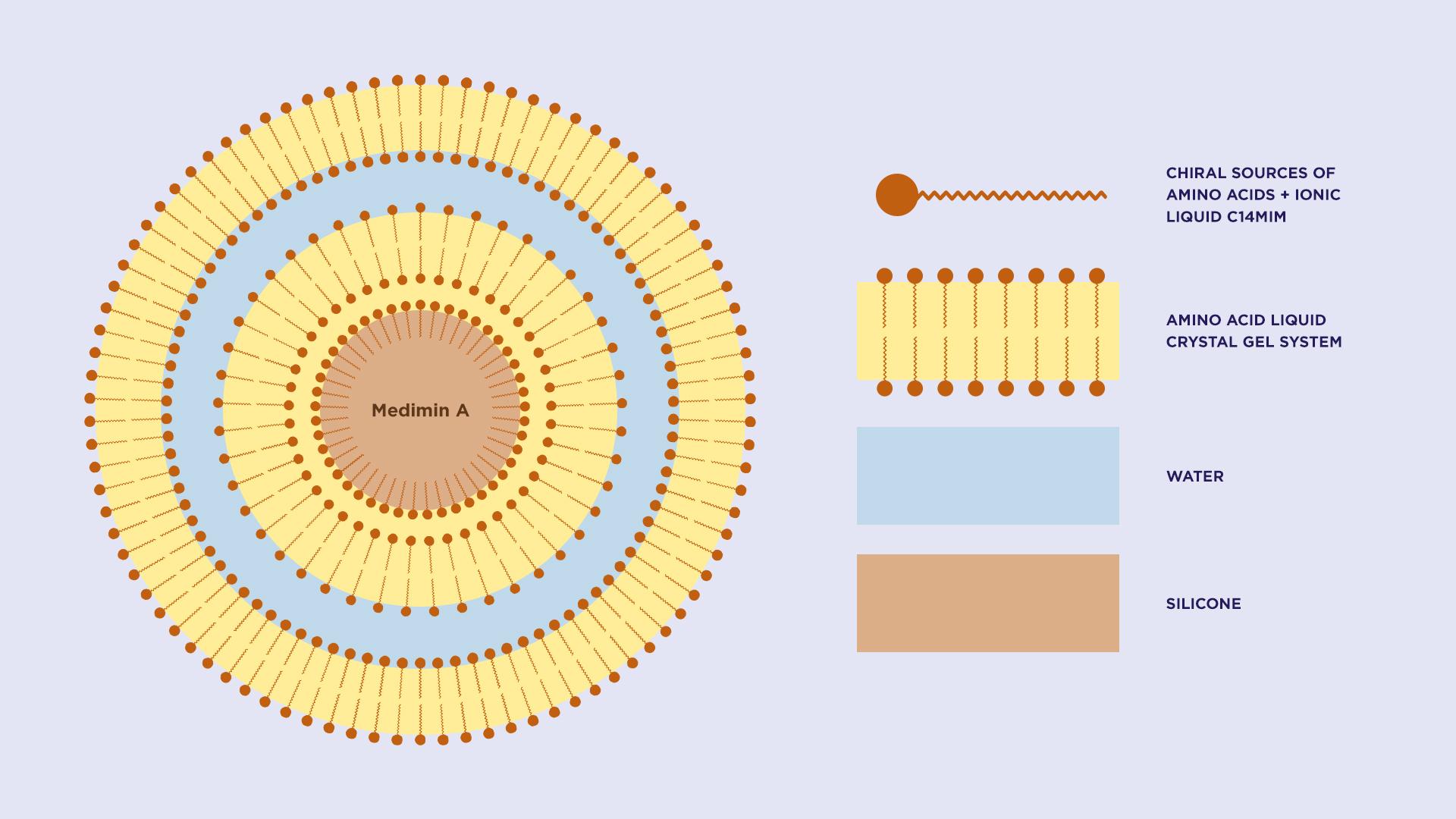
In multiple clinical studies conducted both by LG and by the Department of Dermatology at Chonnam National University, Medimin A was found to be three times more effective in boosting collagen production compared to traditional Retinol. Secondly, Medimin A is more biologically active than traditional Retinol because it only goes through one conversion to become Retinoic Acid, whereas Retinol takes two.
Additionally, Medimin A was shown to offer higher stability, better absorption and less irritation than Retinol and other Retinoic Acid derivatives available at the end of the 90s when the studies were originally conducted.
Medimin A earned patents in 20 different countries and was honoured with the KT Mark (KT 마크) for Excellent Korean Technology by the Ministry of Science. In 2000 LG’s groundbreaking work on Medimin A was also recognized with the prestigious IR52 Award, the most important government award for technological innovation in Korea.

[source: 중앙일보]
3.2 Isa Knox’s “Wrinkle Decline”
LG’s Medimin A played a very important role in the history of the Korean beauty industry.
Medimin A was initially created by the LG Group specifically for “Wrinkle Decline”, an anti-aging serum that was introduced as part of their Isa Knox brand back in 1999.
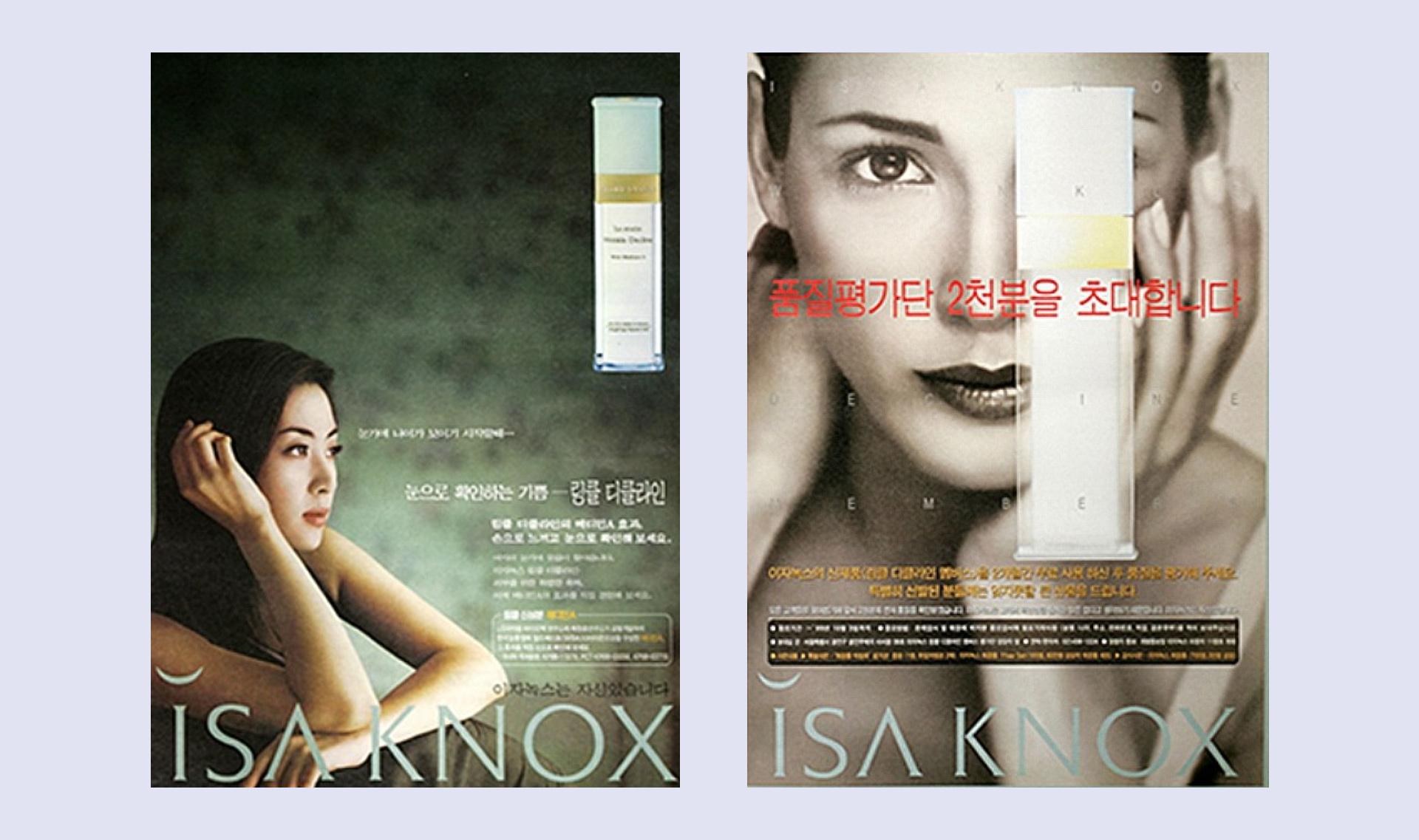
print ads for Isa Knox’s “Wrinkle Decline” (1999)
As the two largest beauty companies in South Korea, there’s always been fierce competition between LG and Amorepacific. It’s very common for rival companies operating in the same industry to launch similar brands with similar concepts and targeting the same demographic that are in direct competition with each other and this also applies to LG and Amorepacific. For instance Amorepacific owns Sulwhasoo while LG owns The History of Whoo, two luxury beauty brands based on modern applications of Traditional Korean Medicine. Again, Amorepacific owns Hera while LG owns O Hui – two luxury beauty brands based on cutting-edge biotechnology and extraordinary sensorial performance.
Isa Knox in this case is positioned as a direct competitor of Amorepacific’s IOPE – it’s premium beauty brand that offers effective products rooted in extensive research and innovative technologies.
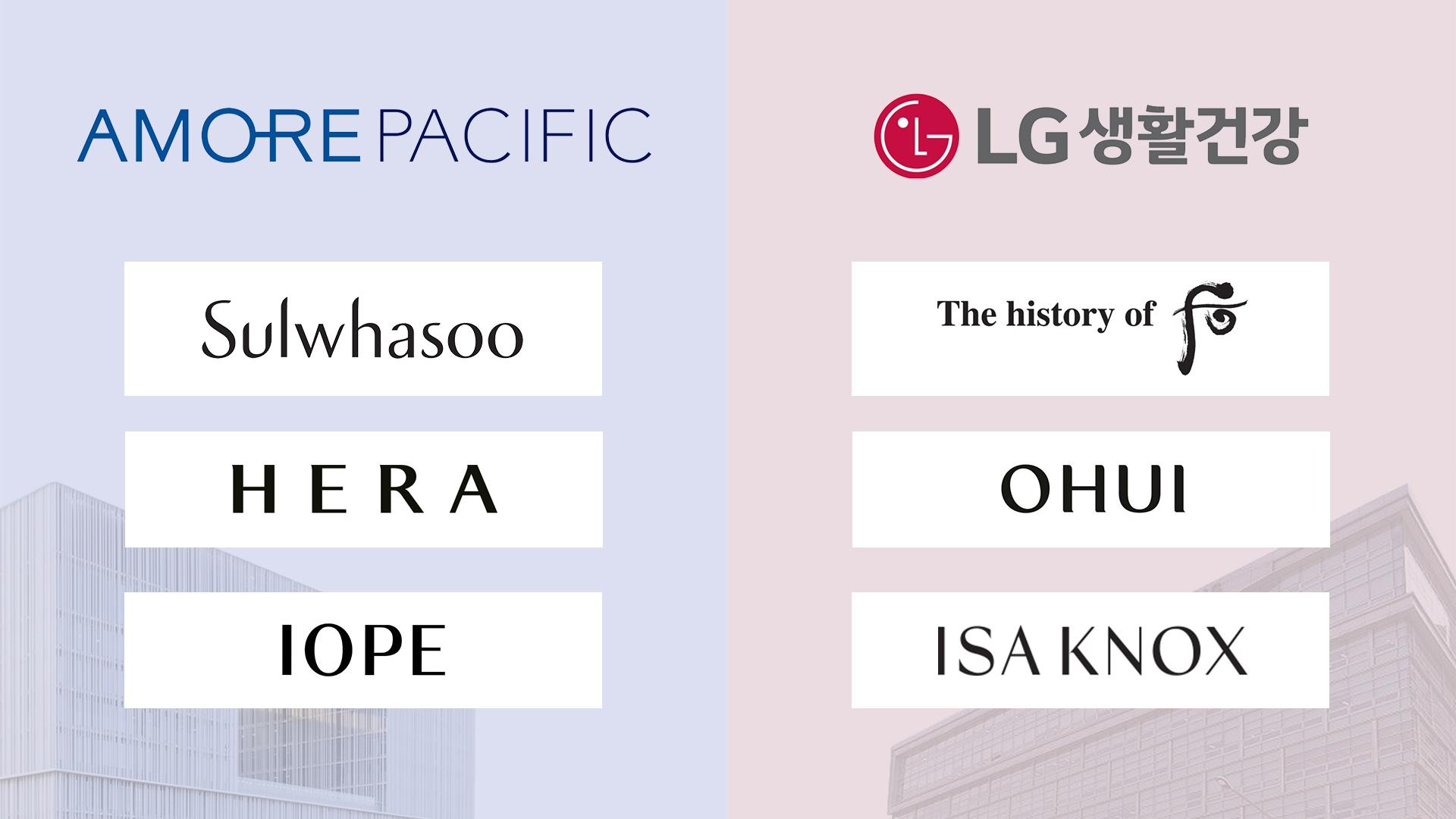
It’s no mystery that the launch of Isa Knox’s “Wrinkle Decline” and the development of Medimin A in general were a direct response to the success of IOPE’s “Retinol 2500”.
However, in an interesting turn of events, LG gained an early advantage over Amorepacific when Isa Knox’s “Wrinkle Decline” became the very first skincare treatment in Korea to receive an official certification for its wrinkle-improving effect.
As I mentioned in the previous part, in South Korea some marketing claims related to skincare like “whitening” or “anti-wrinkle” are strictly regulated by the local authorities and subject to a process of pre-market testing & approval. This approval system dates back to 2001 when the Cosmetic Act was introduced in South Korea. In that same year, Isa Knox’s ”Wrinkle Decline” became the very first product in Korea to be approved by the authorities for its ability to reduce the appearance of wrinkles.
It’s worth noting that IOPE’s “Retinol 2500” also earned the same certification, albeit a bit later. And yet, this initial advantage allowed LG to position themselves at the forefront of anti-aging skincare treatments in Korea in the early 2000s. The news of “Wrinkle Decline”’s official certification spread quickly across the country and elevated the product’s reputation and credibility among the Korean general public.
As a result, Isa Knox’s “Wrinkle Decline” became an instant hit, selling over 1 million units within its first three years and for 20 consecutive years, the serum remained one of the brand’s top bestsellers.
Over time, it underwent several changes. In 2005 it was relaunched as the “Wrinkle Decline-Double Effect”, in 2012 it became the “X2D2 Wrinkle A440 Serum”, three years later it was reformulated again as the “X2D2 Wrinkle Focus Serum” and in 2016 it was relaunched as the “Age Focus Phyto Pro-Retinol Wrinkle Serum”.
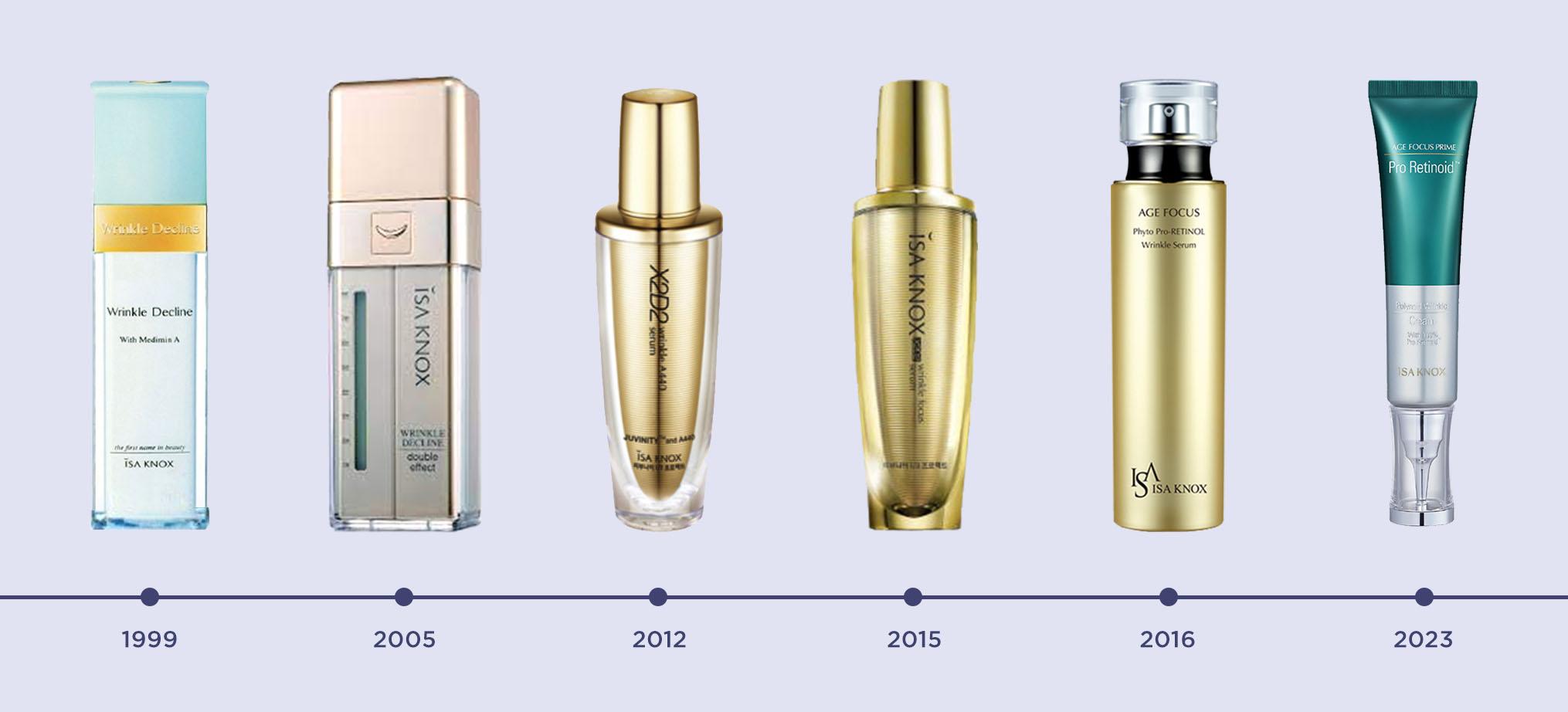
3.3 Isa Knox’s “Age Focus Prime Polynoid Wrinkle Cream”
Finally in September 2023, LG introduced a new upgraded edition of their iconic retinoid treatment: “Age Focus Prime Polynoid Wrinkle Cream”.
See also:
- Isa Knox- Age Focus Prime Polynoid Wrinkle Cream [ingredients and details]
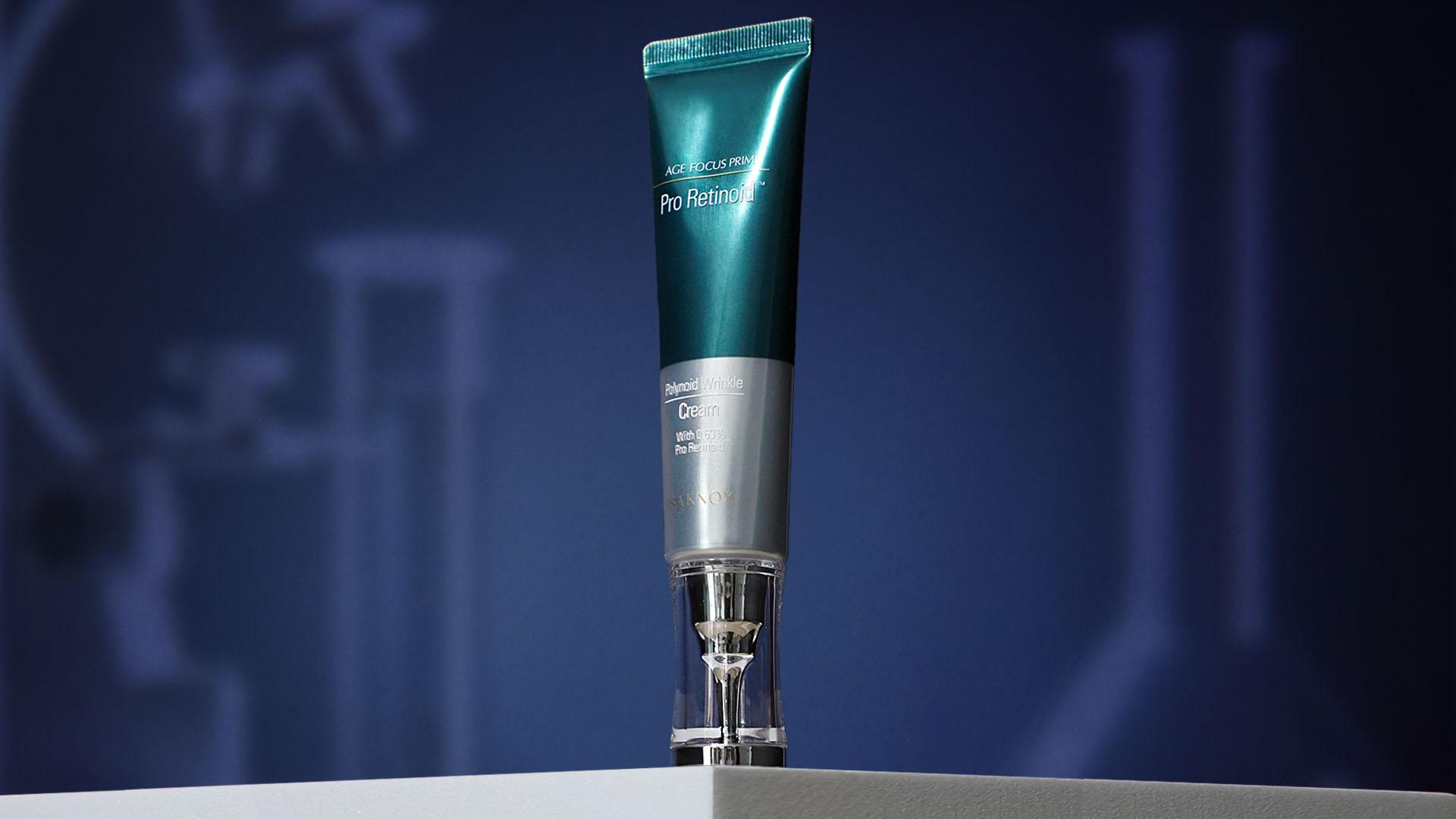
The standout feature of this upgraded formula is the addition of encapsulated Medimin A.
The Medimin A included in the new “Prime Polynoid Wrinkle Cream” was in fact formulated using an advanced encapsulation technology that improves the stability and effectiveness of the ingredient compared to its predecessor.
Along with this new enhanced form of Medimin A, the new “Prime Polynoid Wrinkle Cream” was also enriched with Granactive Retinoid, as well as Bakuchiol, a plant-derived anti-aging ingredient that is often touted as a natural alternative to Retinol because research has shown they seem to offer similar benefits.
And while I find this comparison unnecessary and frankly misleading, I also don’t think it’s fair to completely dismiss Bakuchiol as an anti-aging ingredient. The research on the benefits of Bakuchiol in skin care shows great potential, but there are other ingredients that offer similar benefits and they’re not being promoted as natural alternatives to Retinol, so I find the marketing around this ingredient could use some improvement.
The new “Prime Polynoid Wrinkle Cream” offers a luxurious, cocooning texture that seamlessly blends into the skin, leaving it soft, smooth and supple. Its thin consistency allows the product to be absorbed quickly without any stickiness or greasiness, providing a comfortable and smooth application.
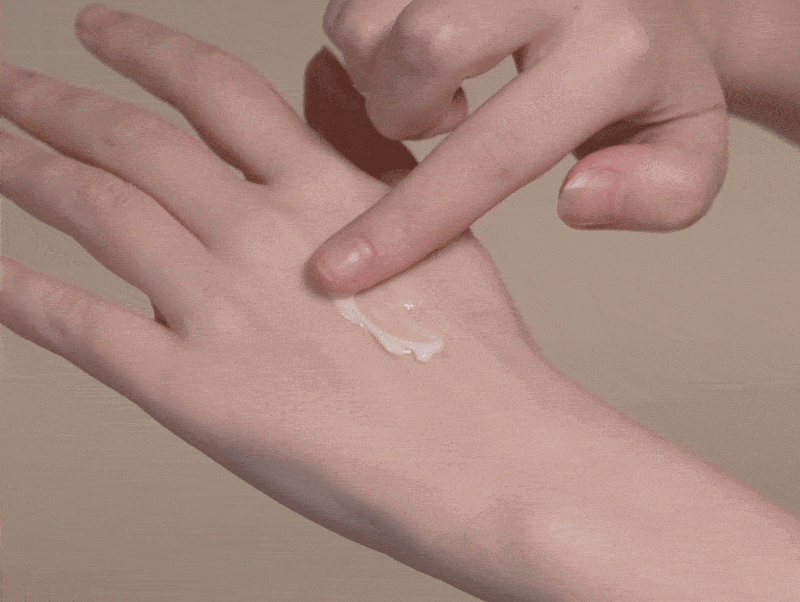
This formula is designed to enhance skin firmness and elasticity, visibly reducing sagginess while providing a noticeable tightening effect,promoting a smoother, more compact, and bouncy skin texture.
The “Prime Polynoid Wrinkle Cream” has a subtle citrus fragrance that fades away almost instantly once applied, so you don’t have to worry if you dislike heavily fragranced products.
3.4 Isa Knox’s “Age Focus Prime Wrinkle For All Serum”
In 2022 Isa Knox launched a serum in the Age Focus Prime line called “Age Focus Prime Wrinkle For All Serum”.
See also:
- Isa Knox- Age Focus Prime Wrinkle For All Serum [ingredients and details]
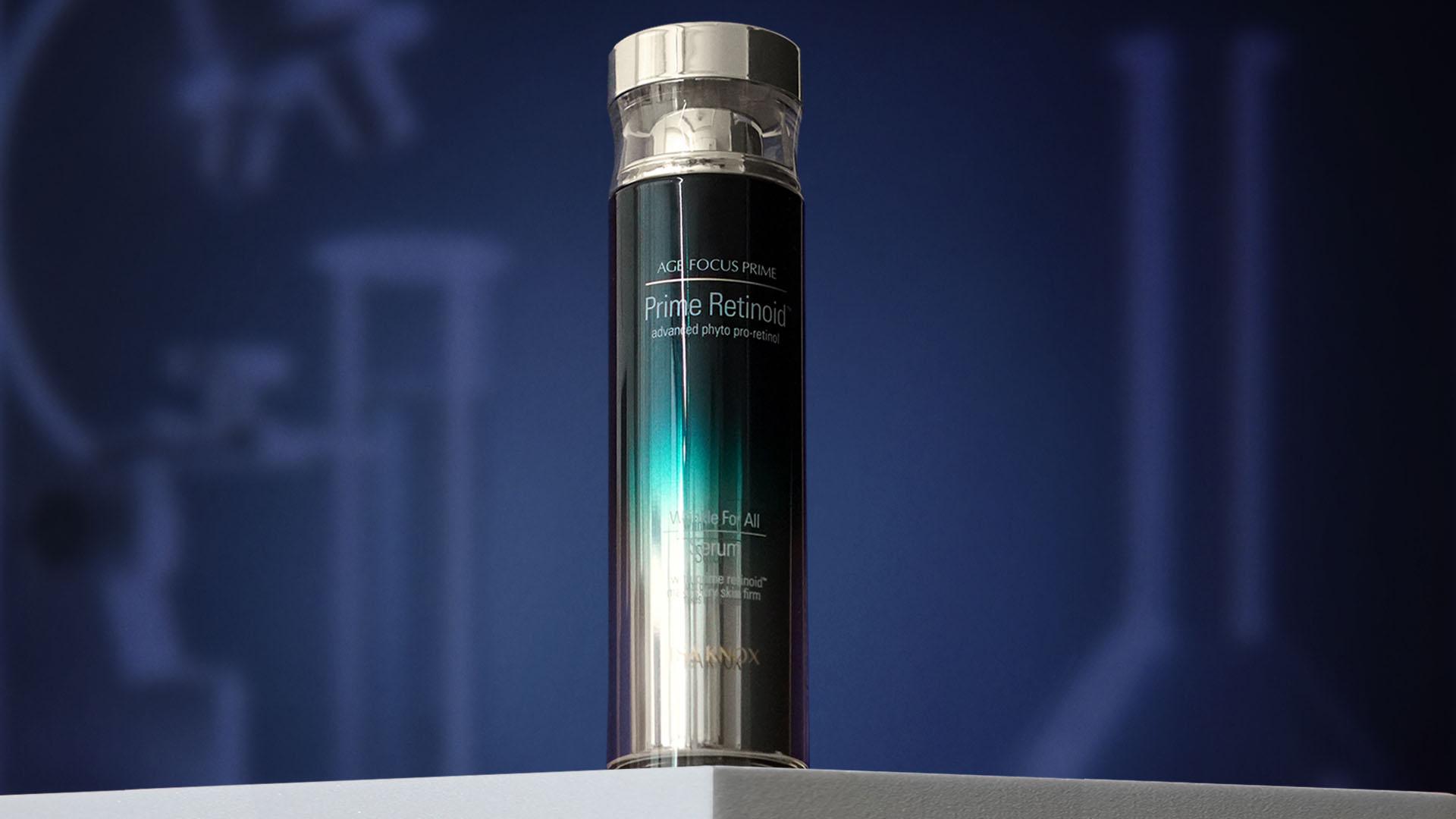
Unlike the “Prime Polynoid Wrinkle Cream” we just saw, this serum doesn’t contain Medimin A, instead its key ingredients are Pure Retinol, Granactive Retinoid and Bakuchiol.
I find the “Wrinkle For All Serum” has a really impressive formula that perfectly complements the properties of Isa Knox’s iconic retinoid treatment. The serum boasts a bouncy gel texture that easily glides onto the skin, filling in wrinkles and providing an instant tightening effect.
Thanks to the incorporation of ingredients like Ceramide, Squalane and Cholesterol, the serum also provides outstanding skin barrier support to minimise irritation and flakiness commonly associated with retinoids. Despite its nourishing formula, the “Wrinkle For All Serum” doesn’t come across as greasy or overly moisturising. Instead, it dries down to a luxurious, silky finish that feels incredibly smooth and soft to the touch.
Both the serum and the treatment make great standalone products, and you don’t necessarily need to use them together in the same routine to achieve visible results. However, I also find that the “Wrinkle For All Serum” does a great job at enhancing the efficacy of the “Prime Polynoid Wrinkle Cream” and when I incorporated both products into my daily routine, I noticed visible improvements in my skin in a shorter period of time.
Part 4: Enprani
If you’re interested in skincare, you’re probably familiar with Medik8. Medik8 is a British beauty company that rose to fame in recent years for its highly-effective skincare products based on innovative and cutting-edge technologies.
One of their most popular offerings is an anti-aging skincare line that contains Retinyl Retinoate, a novel retinoid derivative that was shown to be 8 times more effective than regular Retinol.
What you probably don’t know is that Retinyl Retinoate was originally developed in South Korea in 2002 by a company called Enprani.
The ingredient is still protected by a patent in South Korea, meaning no one else in Korea is allowed to use it except Enprani. However their international patent expired a few years ago and that’s why Western beauty brands only recently started to incorporate the ingredient into their products.
Medik8 in particular revealed that they source the retinyl retinoate used in their products from a government award-winning lab in Korea, clearly hinting that they are sourcing it from Enprani.
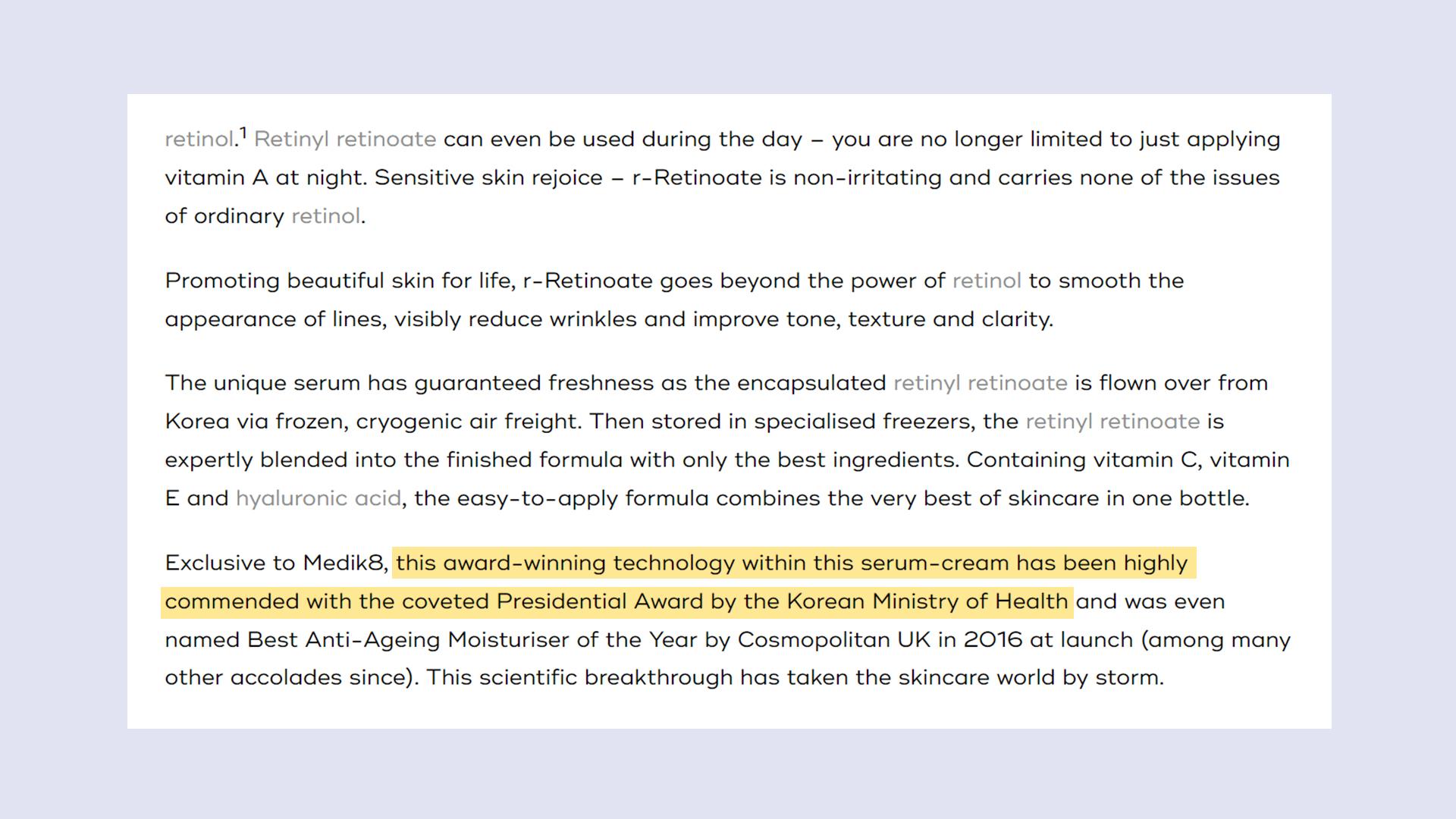
[source: Medik8]
4.1 Who’s Enprani
Launched in October 2000, Enprani is a premium beauty brand that was originally founded by the CJ Group, which is one of the largest conglomerates in South Korea, offering a wide range of products and services across industries like food, pharmaceuticals, entertainment, retail, logistics and beyond.
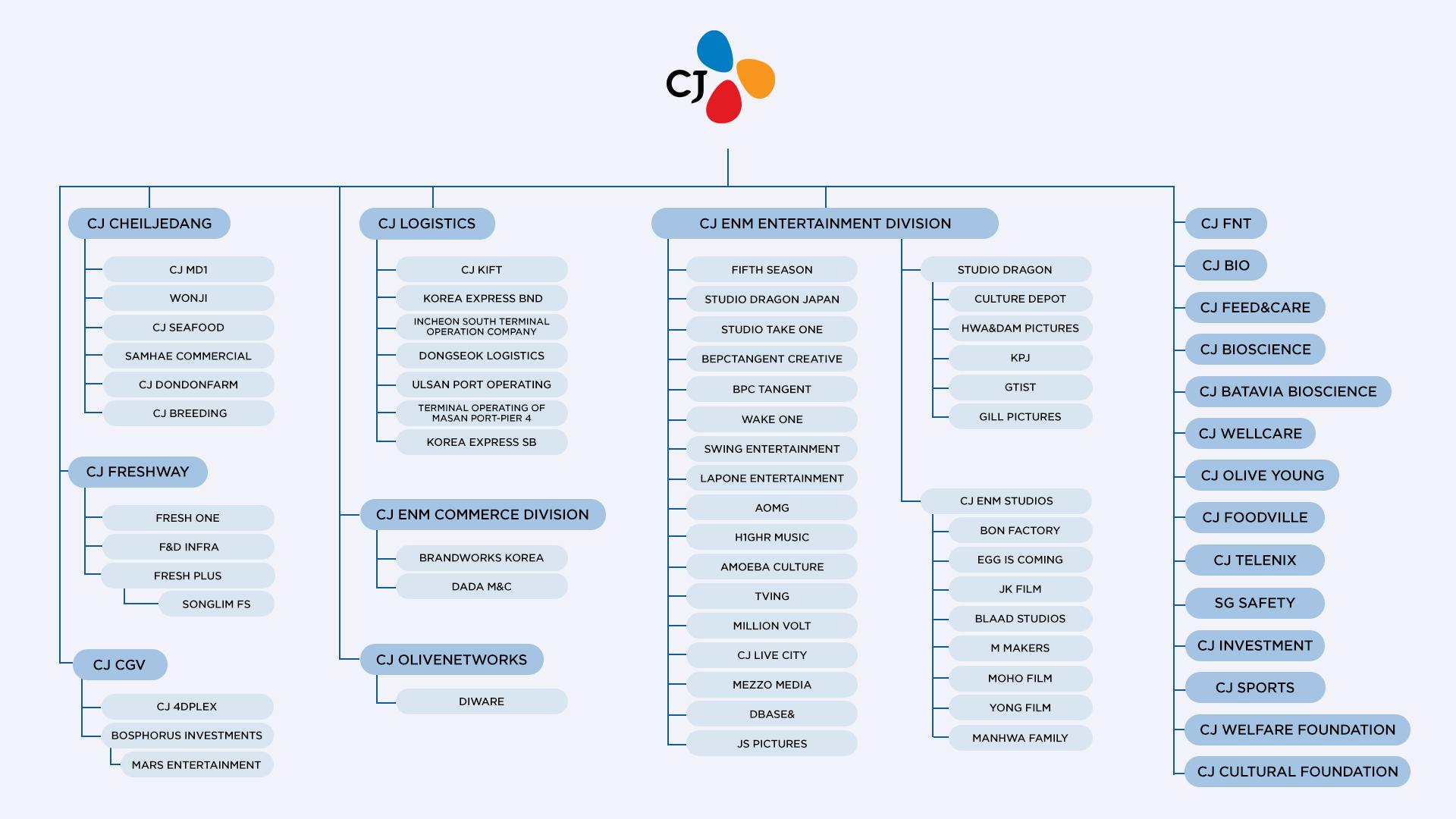
[source: CJ Group. Translation & Visuals: Odile Monod]
After a very successful launch, in January 2002 Enprani made the brave decision to part ways with CJ and establish itself as an independent company.
However, being initially part of the CJ umbrella, Enprani had a significant advantage over smaller beauty brands that were just starting out because they could leverage CJ’s financial resources and extensive expertise within the biochemical industry to establish their own research team.
4.2 The Development of Retinyl Retinoate
In 2001, the Enprani Skin Science Research Institute (엔프라니 피부과학 연구소) started working on the development of a novel retinoid ingredient that could overcome the shortcomings of Retinol, while delivering effective results at the same time. The project instantly caught the attention of the domestic beauty industry and in 2004 the Ministry of Health and Welfare decided to financially support the project as part of their initiatives to promote technological innovation in South Korea.
[In case you’re wondering – that’s the government award mentioned on the Medik8 website.]

In 2007 Enprani finally unveiled Retinyl Retinoate, a new generation hybrid retinoid formed by combining Retinol and Retinoic Acid.This particular combination makes the ingredient more stable and more active than traditional Retinol.
For starters Retinyl Retinoate only goes through one conversion to become Retinoic Acid, the most active form of Vitamin A. Once it comes in contact with the skin, Retinyl Retinoate immediately breaks down into Retinoic Acid and Retinol. Retinoic Acid becomes instantly active, while Retinol can transform into more Retinoic Acid later.
Besides being more biologically active than traditional Retinol, this gradual conversion also reduces irritation by preventing sudden spikes in Retinoic Acid. Additionally, clinical studies showed that the application Retinyl Retinoate was associated with less water loss through the skin compared to Retinol, Retinoic Acid, and Retinaldehyde, suggesting that the ingredient may cause less skin damage and irritation than other retinoids.
Furthermore, in multiple clinical studies conducted by the Enprani research team, Retinyl Retinoate was shown to stimulate collagen production up to 8 times more than traditional Retinol as well as penetrate skin 7.6 times faster. And unlike ordinary Retinol, Retinyl Retinoate was not sensitive to light, making it more convenient to use during the day.
The discovery received wide acclaim in the domestic beauty industry and shortly after Enprani published the clinical studies on the efficacy of Retinyl Retinoate in international scientific journals, the ingredient received the New Excellent Technology Certification (NET) from the Korean Ministry of Science & Technology.
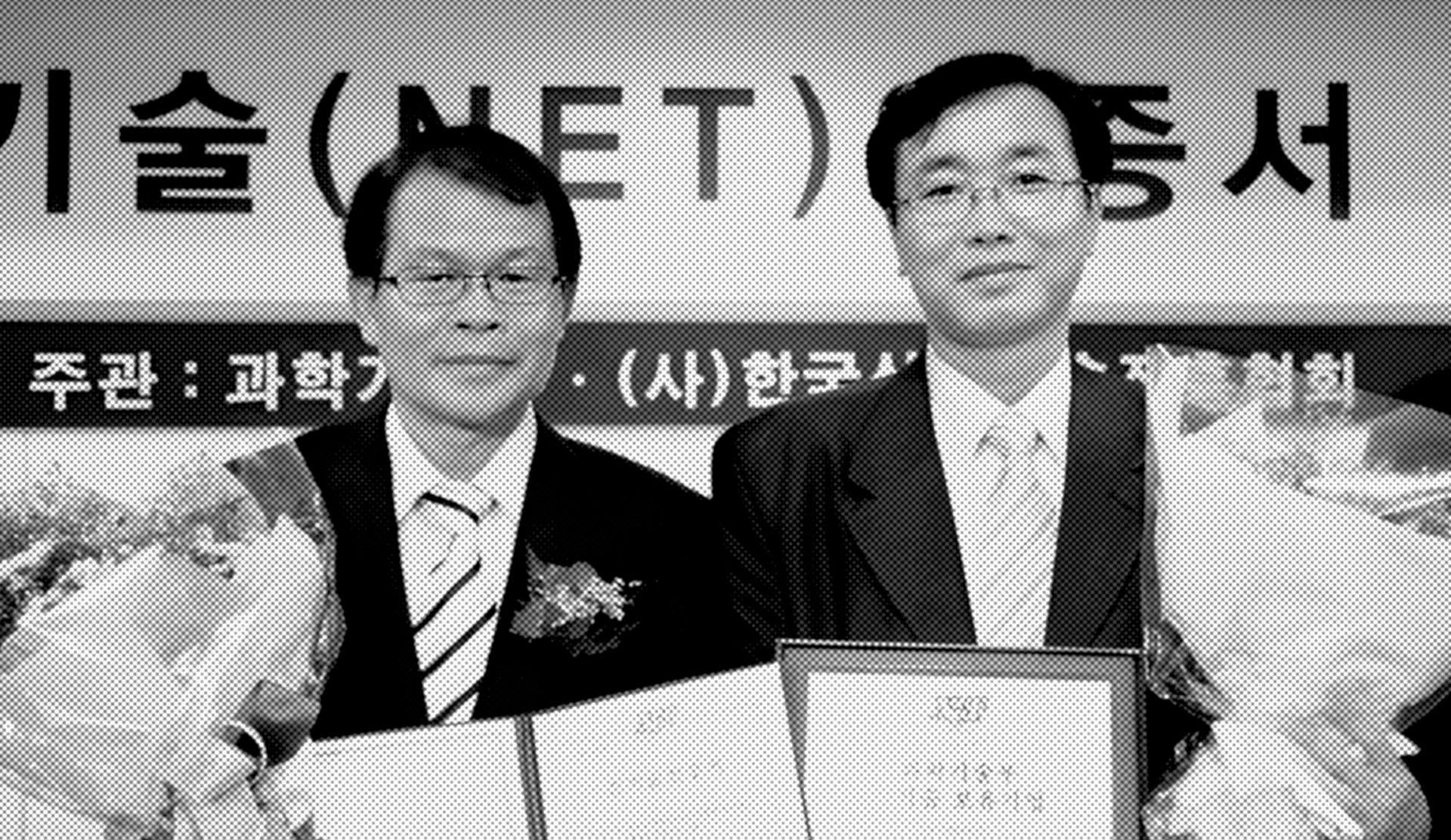
[source: 중앙일보]
4.2 Enprani’s “Retino X8 Pro” range
But it was only in 2008 that Retinyl Retinoate became available to the public, when Enprani launched “Retino X8 Pro”, a groundbreaking anti-aging skincare line formulated to enhance skin firmness, density, and elasticity.
The line was an instant success and to this day, it’s the brand’s number 1 bestseller in Korea.
Along with Retinyl Retinoate, the line was enriched with Penta-Peptide™, a combination of 5 different peptides designed to improve the appearance of all major signs of skin aging, ranging from decreased elasticity, uneven texture and sagging skin.
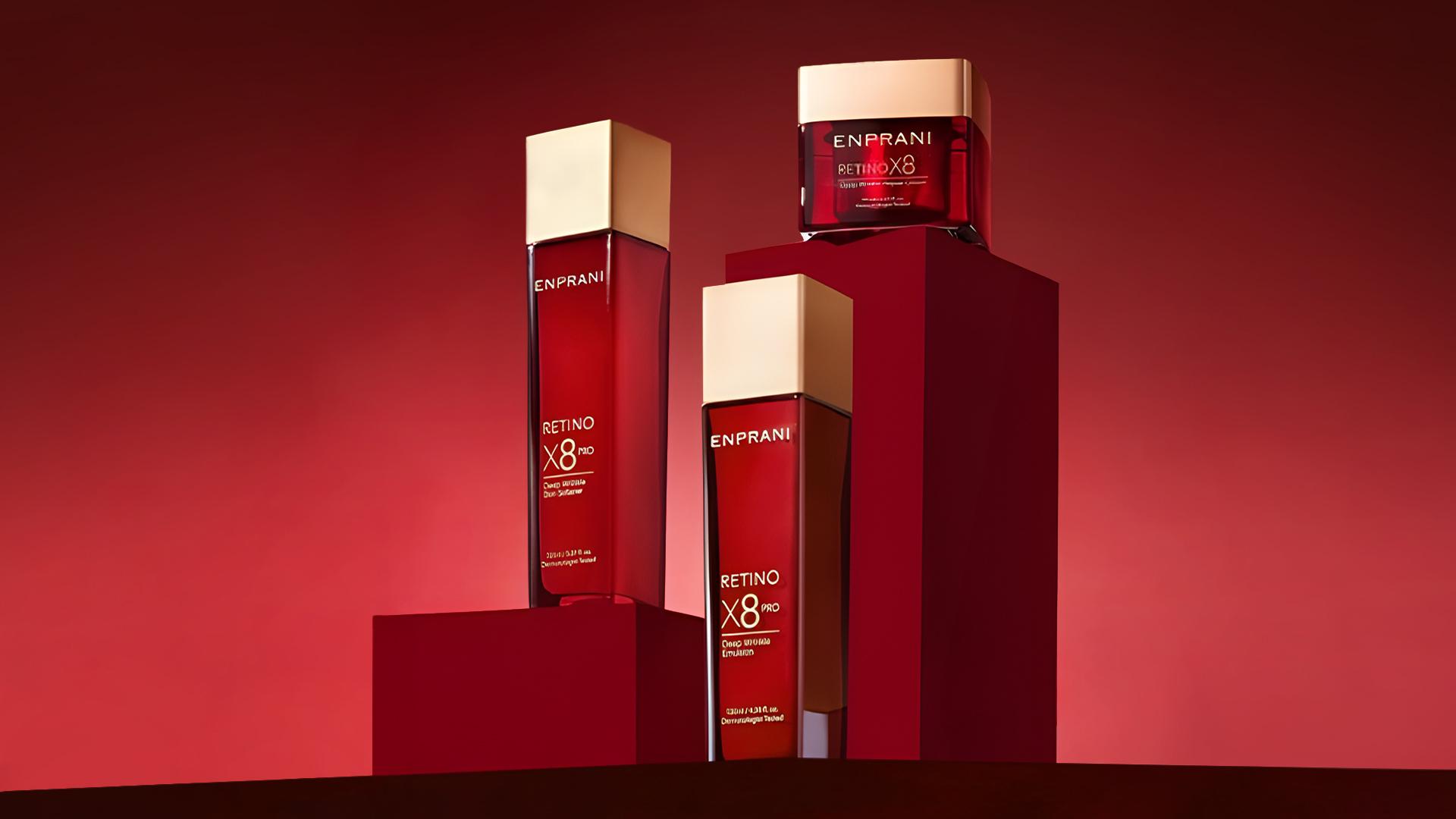
[source: Enprani]
The hero product of this line is a treatment called “Retino X8 Pro Extra Repair Solution”.
See also:
- Enprani – Retino X8 Pro Extra Repair Solution [ingredients and details]
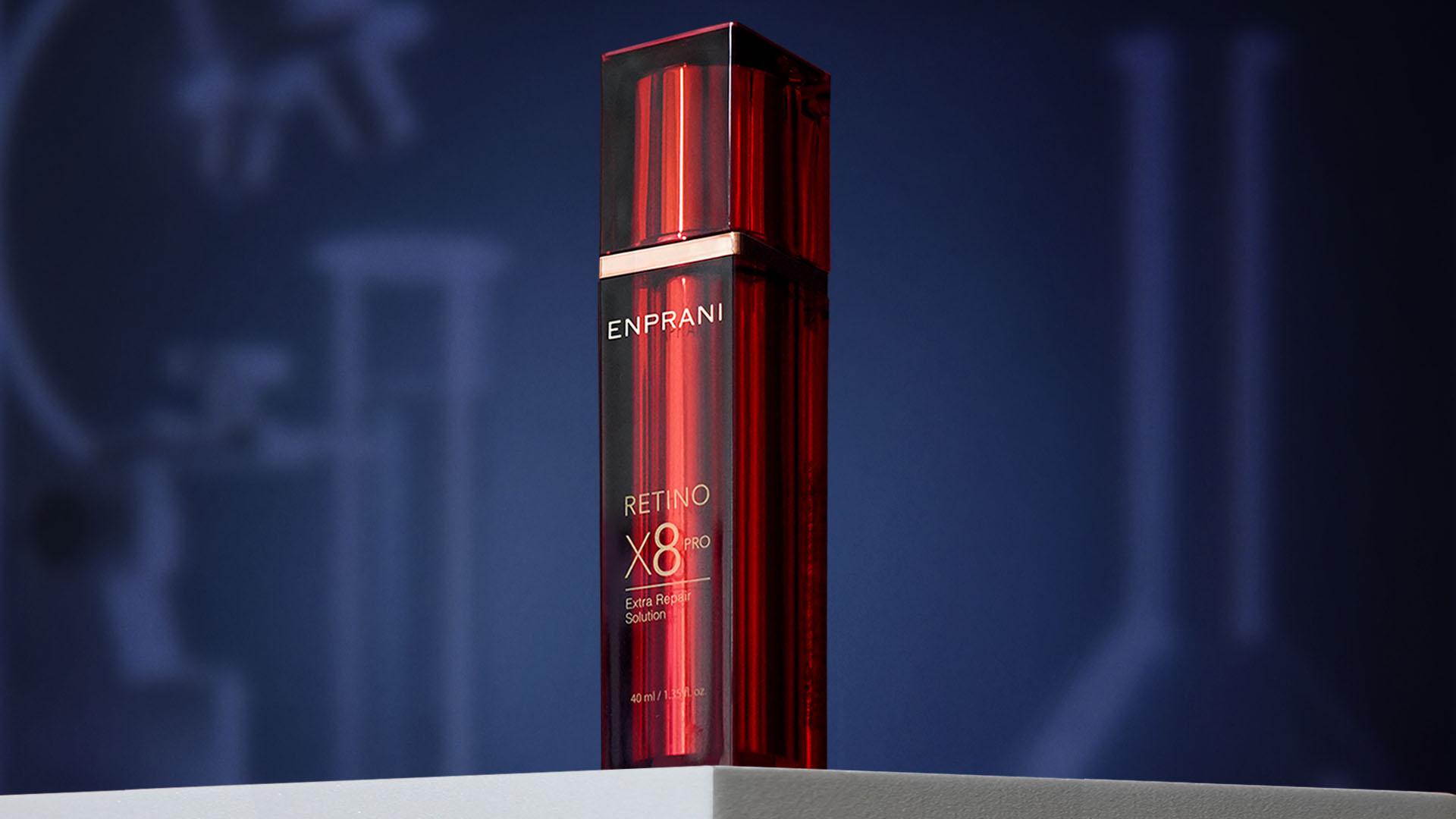
Out of all the products I covered in this guide, the “Retino X8 Pro Extra Repair Solution” is the one that boasts the most weightless formula. Despite leaving skin incredibly smooth, soft and supple the serum has a milky, lotion-like texture that instantly sinks into the skin and absorbs within seconds without tackiness or greasiness.
This makes it perfect for layering under make-up or a rich cream. Although Retinyl Retinoate is considered more active than Retinol, I never experienced any irritation with this serum and when I incorporate it in my skincare routine, I find that it makes my skin truly bouncy and tonic within the first weeks of use.
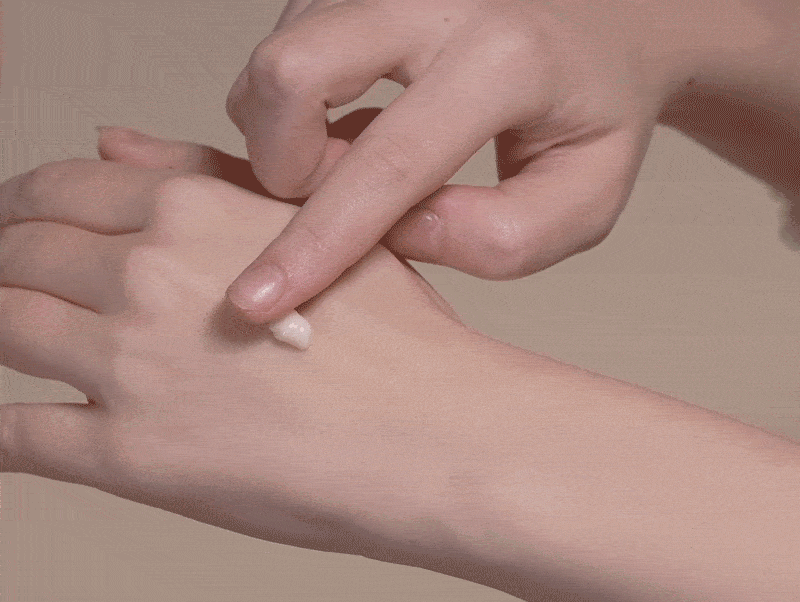
The “Retino x8 Pro Extra Repair Solution” contains fragrance but it’s a very weak floral fragrance that fades almost immediately.
4.3 Enprani’s “Bota Retinol Youth Repair Solution”
In 2023 Enprani launched a new serum targeted to a younger demographic called “Bota Retinol Youth Repair Solution”.
See also:
- Enprani – Bota Retinol Youth Repair Solution [ingredients and details]
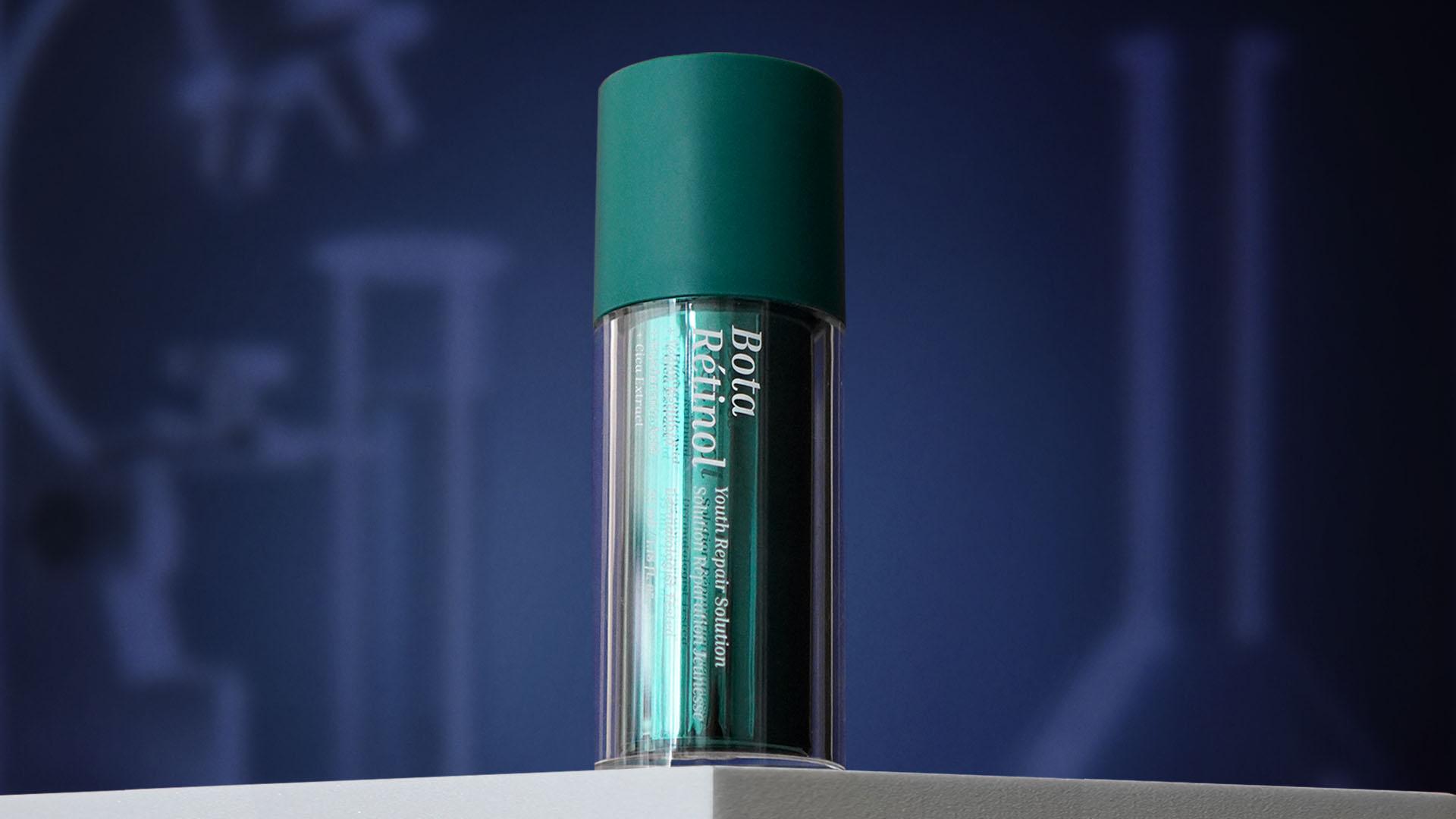
Compared to the products in the “Retino x8 Pro” line, this new serum contains a smaller amount of Retinyl Retinoate and it’s designed with highly-sensitive skin in mind. The formula was in fact enriched with soothing and skin-barrier supporting ingredients to reduce any potential irritation and it doesn’t contain fragrance or essential oils.
Given that the “Bota Retinol Youth Repair Solution” serum was specifically formulated to provide a gentler approach compared to the Retino X8 Pro serum, I find that it takes 2-3 months of regular use to see the first results and even then, the results are not as dramatic.
So unless you have very sensitive skin, I personally recommend going for the “Retino x8 Pro Extra Repair Solution” to achieve the best results.
Words, Visuals: © 2024 Odile Monod unless otherwise stated.
The reproduction of any content, either in whole or in part, for commercial purposes is strictly prohibited without obtaining the explicit written consent of the author.
Selected Sources and Suggestions for Further Reading
- 2000 년 23 주차 장영실상 수상제품목록보기 LG화학 이자녹스 링클디클라인. IR52 장영실상. (2000, June 5). https://www.ir52.com/award/weekly.asp?smenu=award&stitle=weekly&yy=2000&wk=23&jscd=007
- [`97 매경히트상품] 대상…아이오폐 레티놀2500 (태평양). 매일경제. (1997, December 18). https://m.mk.co.kr/amp/1895614
- [IR52 장영실상] LG생활건강 `링클 디클라인’. (2000, June 3). https://n.news.naver.com/mnews/article/009/0000016452?sid=105
- [IR52 장영실상] LG생활건강 `링클 디클라인’. 매일경제. (2000, June 3). https://www.mk.co.kr/news/all/2324745
- [장수 브랜드] (주)아모레퍼시픽 – 아이오페(IOPE). 장업신문. (2009, November 3). https://www.jangup.com/news/articleView.html?idxno=49226
- IGAWorks (2023). 스레드 앱 분석 리포트
- ImpactPeoples (2021). 중장년들의 외모 관리에 대한 관심과 화장품
- Kang, S., Kim, K., Jun, S.-H., Lee, S., Kim, J., Shin, J.-G., Kim, Y., Kim, M., Park, S.-G., & Kang, N.-G. (2021). Anti-irritant strategy against retinol based on the genetic analysis of Korean population: A genetically guided top–down approach. Pharmaceutics, 13(12), 2006. https://doi.org/10.3390/pharmaceutics13122006
- Kim, H., Koh, J., Baek, J., Seo, Y., Kim, B., Kim, J., Lee, J., Ryoo, H., & Jung, H. (2011). Retinyl retinoate, a novel hybrid vitamin derivative, improves photoaged skin: a double-blind, randomized-controlled trial. Skin research and technology : official journal of International Society for Bioengineering and the Skin (ISBS) [and] International Society for Digital Imaging of Skin (ISDIS) [and] International Society for Skin Imaging (ISSI), 17(3), 380–385. https://doi.org/10.1111/j.1600-0846.2011.00512.x
- Mezzo Media (2023). 2023 화장품업종분석리포트
- Song, Y.-S., Chung, B.-Y., Chang, M.-Y., Park, M.-E., Lee, S.-J., Cho, W.-G., & Kang, S.-H. (1999). Development Of Polyethoxylated Retinamide As An Anti-aging Agent. Journal of the Society of Cosmetic Scientists of Korea (대한화장품학회지), 25(4), 145–154.
- 김유정, 김현정, 유재원, 김용진, 김도훈, 박성일. (2016). KR102552729B1 – 높은 제형 안정성을 갖는 화장료 조성물 (Patent No. KR102552729B1). Korean Intellectual Property Office 대한민국특허청. https://patents.google.com/patent/KR102552729B1/en
- 김효정, 김혁, 정성원, 이주동, 유희창, 손정관, & 주식회사엔. (2002). KR100503631B1 – 레티놀 유도체 및 그의 제조방법 (Patent No. KR100503631B1). Korean Intellectual Property Office 대한민국특허청. https://patents.google.com/patent/KR100503631B1/en
- 동아일보. (2020, January 21). [beauty&]안티에이징의 대명사 ’아이오페 레티놀’의 모든 것. 동아일보. https://www.donga.com/news/amp/all/20200121/99351672/1
- 엔프라니, 기술력 국가에서 인정. 인쇄하기. (2004, October 21). http://www.bosa.co.kr/news/articlePrint.html?idxno=56872
- 엔프라니, 신기술인증(NET) 획득. 뉴스와이어. (2007, August 23). https://www.newswire.co.kr/newsRead.php?no=275782
- 이성준, 송영숙, 조완구, 강세훈, 정봉열, 김영근. (1998). KR20000046973A – 폴리에톡실화 레틴아미드를 함유하는 노화방지용 화장료 조성물 (Patent No. KR20000046973A). Korean Intellectual Property Office 대한민국특허청. https://patents.google.com/patent/KR20000046973A/ko
- 이충남, 이옥섭, 강학희, 박동순. (1996). KR0173445B1 -화장료용 이중캡슐 및 이를 함유하는 화장료 조성물 (Patent No. KR0173445B1). Korean Intellectual Property Office 대한민국특허청. https://patents.google.com/patent/KR0173445B1/en
- 정봉열, 김영근, 이인상, 박봉준, 조완구, 송영숙, 박문억, 김영득, 이성준. (1999). KR100297061B1 – 폴리에톡실화 레틴아미드 유도체 및 그의 제조방법 (Patent No. KR100297061B1). Korean Intellectual Property Office 대한민국특허청. https://patents.google.com/patent/KR100297061B1/ko
- 조선일보. (2016, February 15). 내 피부에… 합성분자·줄기세포를 바른다. 조선일보. https://www.chosun.com/site/data/html_dir/2015/12/08/2015120800663.html
- 최신의 순수 레티놀 안정화 기술: 아모레퍼시픽. 최신의 순수 레티놀 안정화 기술 | 아모레퍼시픽. (n.d.). https://www.apgroup.com/int/ko/about-us/research-innovation/rni/beauty-research-innovation/beauty-research-innovation-07.html
- 피부관리에 적극적인 신중년, 지갑 팍팍 연다. 톱클래스. (2021, May 25). https://topclass.chosun.com/news/articleView.html?idxno=21105#_mobwcvr
- 피부노화지연’레티놀’상품화 성공 아이오페 태평양. 매일경제. (1997, June 23). https://www.mk.co.kr/news/economy/1769390
